TAPE 79/AF/01
THIS TAPE HAS BEEN RECORDED ON THE 25th of JULY 1979 AT MARY WILKIN’S HOME, 10 MOORVIEW IN SALTERFORTH. THE INFORMANT IS MARY WILKIN, WEAVER AND THE INTERVIEWER IS STANLEY GRAHAM.
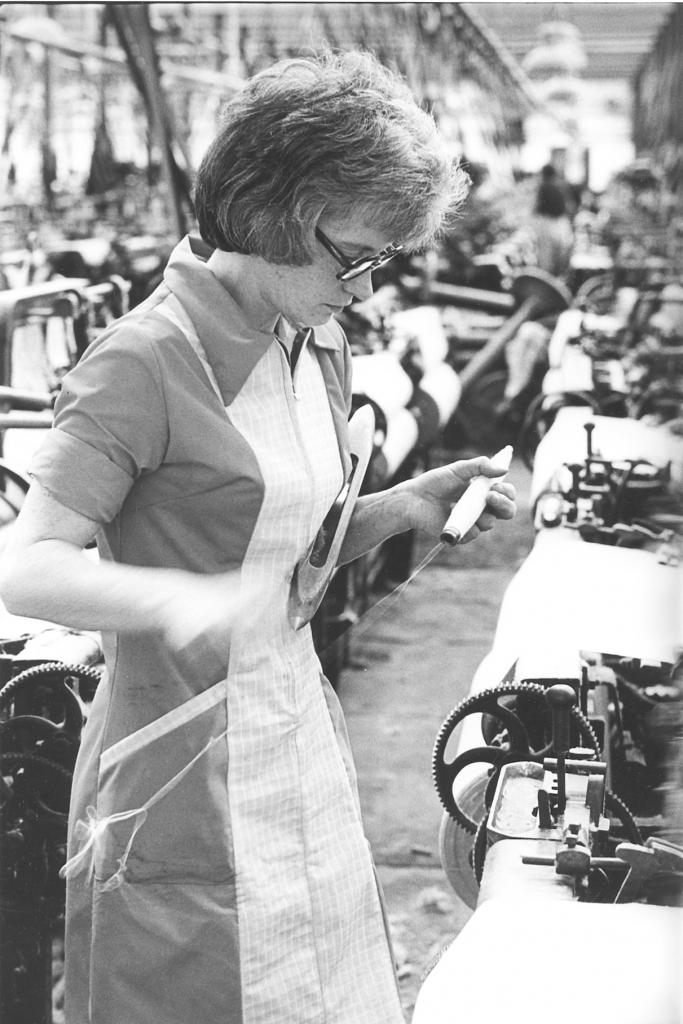
Mary Wilkin. Always clean and tidy and as clean when she went out of the shed after a day's work as when she came in. Jim Pollard reckoned she was perhaps the best weaver in the shed.
[SG note: Mary Wilkins was arguably the best weaver in Bancroft Shed. Her husband didn’t agree with the fact that I was interviewing her and there was some obstruction.]
Now I’m going to start this tape. What I’m going to do Mary is to just ask you a few questions. Normally I do a complete tape of people right from when they were born but, and this might make you laugh, but you are just not old enough Mary and that’s it. We’ll go through your early life quickly. But I want to talk to you particularly about working: at Bancroft, weaving at Bancroft and then we'll go through the pictures another day. Now then, how old are you?
R - Thirty-eight. [Born 1941]
And where were you born Mary?
R- Salterforth.
And you live In Salterforth now?
R – Yes.
And whereabouts were you born in Salterforth?
R - There used to an old cottage up at t’side of the Anchor Inn, pulled down now.
On the canal bank?
R – No. It’s at this side of the Anchor, village side of the Anchor.
And you were born there? And what did your mother do?
R – Well, she were a policeman's daughter. I don’t know, she work on the farm a bit, worked a bit at Rolls, a bit at a cake shop and a bit at Silentnight you know.
Aye. And what did your dad do?
R - Oh I don’t know.
So you were brought up just by your mother? Where did you go to school Mary?
R - Barnoldswick.
Aye. That's right, Barlick, which school?
R - Gisburn Road and then Modern school.
Aye. And you left there what year?
R - Oh heck ... 1956 I think.
Nineteen fifty six?
R - Yes, it would be.
And when you left school .. what jobs were there in the town that you could have gone to?
R- Oh mostly all textiles.
Hold on a minute .. 1956?
R - There were a lot of mills round here.
Wait a minute, 1956, you couldn’t have left school in 1956 ...
R - I did! I were married in 1959.
Nineteen fifty-six ... And how old are you?
R - Thirty-eight.
Oh I'm sorry Mary, I'm sorry, I thought you said 48.
R - Thank you very much for that!
I'm sorry Mary, I thought you said ... (Mary's dog barks)
R - That's what Susie thinks about that.
(100)
I thought you said 48. Right, well that's OK then, so you left school in 1956.
R - Fifty six.
What jobs were open to you in town then?
R - Oh ... well mostly textiles. Textiles, I went to work at Armorides for a bit then I left Armorides and come to work at Salterforth. I learned to weave at Salterforth. I left Salterforth and went down to Booth and Speak at Earby for six months and come back to Salterforth.
So you learnt to weave at Salterforth. What sort of jobs did the ... did you have any career advice, you know, when you left school.
R - No I don’t think so, not like there is nowadays. No, you take your pick you know?
That's it. Now how old were you when you went to Slaters?
R - Sixteen.
When you went to Slaters to learn to weave did you go under an apprenticeship scheme or anything like that?
R - No I just went.
Yes. Had you ever been in the mill before in your life?
R- No.
And when you went there how were you taught, who taught you?
R- Eh, a weaver taught me. Just learn ... Well, just see for yourself and pick it up you know. She showed me, watch and learn, so to speak you know?
Aye, just as we used to do at Bancroft in other wards. So you'd go with a weaver on, what were they on there, eight looms or ten?
R - Eight looms.
Eight looms.
R – No, were they eight? Six? Eight I think. Eight yes.
Aye. And what were they weaving? What sort of stuff?
R - Rayon and then they moved on to silk, filament silk.
Yes. And what was the wage then?
R- Oh heck. I started on two pound fifty, that was me learning wage. Two pound, two pound fifty, two pound ten shillings.
Two pound ten shillings, that's it, aye. And how long was it before you got on looms of your own?
About a month.
R- I went on two loom I think. Two, four looms, sommat like that. I had two or else four looms, I can't remember. Four I think.
What did you think about weaving when you were learning. You know, what did you, what were your impressions of weaving when you were learning.
R- I quite liked it. It was noisy, it's only natural you know? Not exactly a clean job, a lot depends what sort of weaving you're doing. You know. It wasn't particularly, spun weaving, rayon weaving, it wasn't particularly dirty, a lot of dust ... filament silk could be dirty. You'd get your hands dirty you know. But a bit noisy. I quite enjoyed It, I still do.
Aye well, it’s good to tell you enjoy it because, I mean, that's what makes you a good weaver. I meant to bring up Ernie Roberts’ tape and play it to you. You know what Ernie said about you on the tape?
R - No.
He said that you were the best Lancashire loom weaver he’d ever seen in his life.
R- Oh, blooming heck ...
So there you are. Anyway…
R- They weren't all Lancashire looms at Slaters you know? I weren’t on Lancashires all the time at Slaters.
What were you on there?
R- They had some Toyota automatics. I ran twelve of them for about ten years.
That was, now, ah well that’s when you came back to Slaters. You went, you were working at Slaters for how long?
R- I were there about two years and then I left for about six mouths.
Why did you leave?
R- Well, I lived down Earby then you see and I thought I'd be nearer, but I wouldn't really, I didn't like it..
So where did you go?
R- I went to Booth and Speaks.
That'd be Albion.
R - Albion now, yes.
What were you doing there?
R - Weaving ten loom there, ten Lancashires on filament silk.
Aye. And what sort of a wage, let's see, that’d be about 1958 would it? 1957?
(200)
R – No. About 1960 I think it’d be. Yes 'cause I were married, yes it’d be about 1960.
Ah well, so you must have been at Slaters for what then? Two or three years?
R- Two or three years before I left yes.
Yes. And what sort of a wage could you get when you went down to Booth and Speak’s?
R- About ten pound a week I think.
It sounds silly doesn’t it nowadays? About ten pound a week?
R- That were a lot of money then.
Yes aye. What sort of a shop was it down there compared with Slaters?
R- Oh I didn't like it, there were too much regimentation, “Don't do this” and “Don't do that” No, I didn't like it at all.
Were they weaving on the engine or on individual motors then?
R- I think it was on the engine, I think, I wouldn't swear to it. I can't remember rightly.
Yes, I think that engine was running in about 1958, something like that there .. fifty-eight.
R- I think so. There were belts anyway I do know that. Belts, yes.
Belts, aye, aye. And .. so you didn't stop there long. How long did you stop at Booth and Speaks?
R- About six months.
And then shifted back to Slaters, yes.
R – Slaters yes.
Yes. And how long were you at Slaters then?
R - Till they closed down, about ten years, ten or eleven years.
When did they close down?
R- Nineteen seventy two.
(10 min)
How many loom were they running then? Roughly?
R- Oh heck. Shed were full. Oh yes, shed were full. About four or five hundred loom I think, I don't know.
Aye .. And of course they were on motors by then, they'd done away with…
R- Not all motors, no not all on motors. Some might have .. mine were on motors, some automatics were on motors and one or two, odd ones were on belts. Like some would have one side on belts and one side on motors. All the Lancashire looms were still on belts.
Yea. Aye. Were they being run by the engine or by electric motors on the shaft?
R - No, no, electric motor, electric motor.
Yes. Which would you rather have of the two? Wait a minute no, that’s, I’m jumping ahead a bit there. Now, when Slaters closed down of course you wanted a fresh job. So where did you go from there?
(250)
R – Well, I didn't want any work at all really for a week or two. I went up to .. ‘cause I had to go to the labour exchange to sign on .. and I told them I didn’t want any work. He says “Sorry, they want weavers up at Bancroft so you’ll have to go. You either had to go you see, or if you didn't go you wouldn't get no benefit. If you went .. and what arrangement you came to with them was up to you like ... So I went and .. told ‘em I couldn't start for a fortnight. I were going to have a couple of week off .. and I went to sign on for a couple of week, then started up there.
Aye. And that was in 1972?
R – Seventy two.
Aye. So you were there ...
R- Just over six year.
Just over six year, aye that’s it aye. And of course when you went to Bancroft you were .. you were working on looms driven by belts off the shaft driven by the engine, yes. And after you'd worked there.. Now, you know, having worked on .. all three systems really. I mean you worked on individual electric motors, electric motors on shafting and running off the engine. Have you any preference?
R- I'll say motors.
You preferred motors. Why is that?
R - Well, for a start you haven't got your belts have you? I mean that’s, a lot of people are frightened of belts, only natural, it's understandable isn't it. And I prefer motors, yes. You stop it and .. like you don't have to wait for all the lot to be running have you, if you’ve got your own individual motor.
Aye that's it yes.
R- See, you don't have to wait for all .. like at Slaters it were individual alleys, you didn't have to wait for the whole lot if your alley motor was running. And up at Bancroft you didn't have to wait, you had to wait for the lot going hadn’t you?
That's it, aye.
R- Well if you got your own individual motors you’re, you are on your own, and you can please yourself.
Aye. And what, how was working at Bancroft compared with Slaters?
(300)
R - Oh, worlds apart. I mean .. Slaters were modern. Well, I’m saying worlds apart… Slaters were modern, Bancroft were ramshackle, run down and nobody bothered but in a way they both had that same easy atmosphere you know, you were comfortable to work in. Like Manager at Slaters at Salterforth, he was a good manager, he’d let you go so far and he’d pull you up. Whereas up at Bancroft they didn't you see, they couldn't care less. So, of the two I preferred Slaters naturally, but I enjoyed working at Bancroft, until the latter end of course.
Which is the more important to you do you think, which is the most important, things being modern and clean, or you know, a good atmosphere to work in? You know? Easy atmosphere.
R - Well, I suppose it could be both ways can't it really. I mean, you want a modern atmosphere, it’s better for you in all ways really if it's a modern clean environment. But again it doesn't really .. if you are not going to like it there it's no good is it. I mean, I was happy up at Bancroft till the latter end and I am happy at Johnson’s.
Yes aye. Now then, when it got to, when it started to get to the far end at Bancroft of course, you finished before the mill closed down. Why did you finish Mary?
R - Wages job, it just got to a point didn’t it, and that were it.
Yes. When you say the wages job, now tell me what you mean. You know, tell me what was wrong with the wages.
R - Well it .. it was the holiday pay you know, you ended up with less for two weeks than you did for a normal week, so to say, in a way, you know?
Yes that’s it. That's the last time, obviously the last Summer holiday pay that you drew, there was a lot of trouble that year wasn't there because …
R - There were, you see we got three weeks wages, and it turned out to be less. Well, I fetched home for three weeks wages less than what I fetch home for a week's wage now. So I mean ... that was the last straw.
Yes aye. When you say it was the last straw, what other straws were there, what else nattered you then?
R – Well, it were gradually going downhill weren’t it? I mean, nobody were bothering, you couldn't get through to nobody, and Birtles weren’t, he
(350)
(15 min)
were never there, he weren't bothered, Jim weren't bothered, so I mean it were dying on its feet weren't it? Natural.
Yes. That’s a good, that’s a good description of it Mary. I’ll ask you more about that in a minute or two you know, more about the things that were going wrong then. And then of course you went down to Johnson’s. Now of course you tell me what it's like working down at Johnson’s now, what the difference is between Johnson’s and Bancroft.
R- Well, for a start it's modern, very modern, clean, spotlessly clean. As far as a weaving shed, as far as you can keep a weaving shed clean. All you have to do is weave and your weft’s fetched for you, your empty bobbins are taken away for you, your waste's collected up, someone comes and takes your traps up. See, your tackler's always there, he is always in the shed, very rare you've to go looking for him, there's no waiting about you know, like no waiting for two or three days for a warp. Your warp's there within .. you've your looms running within half an hour more often
than not you see? I like it, it's clean, yes I really do, I enjoy working there.
Aye, yes. Fred [Inman] were telling me that you were going on well there. I'm glad you are. Now, weaving itself. Trouble is I've really no, you see I’ve never done any weaving you see and it .. all I can do is look at weaving from the outside. Weaving seems to me .. you tell me whether I’m wrong, weaving seems to me, the biggest part of a Lancashire loom weaver's job seems to me to be shuttling, filling shuttles and keeping shuttles going. Now obviously that isn’t all there is to it. Now, the best thing to do is, you take me through what’d be say a normal day’s work at Bancroft. You know, starting in the morning when you go there, what you'd do and ... you tell me a bit about weaving, and if there is anything I want to ask you I’ll ask you while you are going on.
R - Well we start work at Bancroft about eight o’clock in the morning. I get there for half past seven, you see in Summer it was all right whereas in Winter it were pretty horrible because there were no lights in the shed.
(400)
That’s it yes.
R – I had to get there soon, you'd to get yourself straight for the day, you had to take the empty bobbins away, two or three trips up to the top. [upstairs] ‘Cause all the weft were in trucks at the top of the shed. You had to take all your empty bobbins away and fill up with all your different sorts of wefts. Fill, you know, fill your weft tins up. You'd to do everything yourself up at Bancroft That’d take about a quarter of an hour Up. Make sure you were straight, that your ends, any ends out, take them up. Oil your spindles ... must always oil your spindles. Stop and have a natter with me mates when they come in and get ready for eight o’clock ready for th’engine setting on then. And then ... when the engine got enough speed up, that took about five minutes, you set your looms on then, if you were lucky. Like you say a lot of it it's shuttling, if you are shuttling it can be boring but you are making your money if you are weaving. It means your looms are running all the time. If you are taking ends up, having traps out and bunches out, your loom just stops so you are not making anything. That were more interesting for the weaver, plenty to do, keep ‘em occupied you know but like I say, you are not earning any money if your looms are stopped. You just carry on like that, best you can you know. Keeping your eye on your looms, always keep an eye on the back as well as the front, 'cause a lot of trouble can start round the back of your loom if you're not watching. And watch out for ends coming down, fill your shuttle, watch for owt dropping off or breaking off, anything. You go for your tackler then right? If you could find him! And that was roughly what you do, and break for your dinner. A bit monotonous I suppose really you know but I enjoy it.
Aye. Well you skipped through weaving very quickly theer ...
R- Well you can’t really describe it unless you, you'd have to be there you see.
No. That's it. Well that's what the pictures are for. I mean we'll get into a better description then, but there were all sorts of problems connected with the way… Really Bancroft was an example of how not to run a weaving shed in many ways, wasn't it?
(450)
R - It was.
Now .. tell me what sort of problems did you get with the fact that you had more than one sort of cloth. I mean, at times you could have four or five or six different sorts of cloth in your looms. What sort of problems does that raise? I mean, they're weaving different and ...
R – Yes, they're weaving different, there’s thick-wefters and thin-wefters, like at Bancroft it ranged from eights weft, which was very thick weft to forty-fours, that was a fine weft. Different cloths, different warps, different prices what you got paid for what you earned. The thick wefters you earned more off them, but you were shuttling more of course. It wouldn't run as long. You had to watch your weft, you'd different sorts of weft so naturally you’d to make sure you didn’t get your wefts mixed up. But basically it was the same you know. We just have to ...’cause some'd run a long time, some’d only run for two or three minutes.
Tell me something. I once remember Ernie telling me something about ... oh, it was something to do with the Shirley rotation. The thing was that if you've got ten looms that were all on the same sort of weft and they’re all running at the came speed, you can more or less get your shuttles running out in rotation couldn't you?
R – Well, if nothing went wrong I suppose you could but you can't rely on that, you've got to allow for ends coming down.
Yea, that's it, aye. Which were the worse sorts for ends coming down at Bancroft?
R – Forty fours definitely, one reds, they are a horrible cloth.
Is that right?
R - Sometimes, you are lucky, you get a good warp and .. but majority of them were terrible, they'd come down in bunches, there were too many ends in, there were too many ends in really.
Yes, and then another problem that we had at Bancroft many a time were the fact that they couldn't afford ... we were waiting for weft many a time weren't we. You were [stood waiting for a weft delivery]
R – Weft and warps and everything.
Aye, and stood theer with your looms empty. And tell me something, you tell me whether, again, whether it's right or not. Am I right in saying ... I seem to remember Jim telling me once that there were certain sorts that you were weaving, you were actually better off with a warp out than the warp in weren't you? You earned more money with the warp out than you did with the warp in?
R – Yes. One reds, things like one reds, ‘cause they were the lowest paid warps there were, one reds, yes. So you got an average for what you got paid for your waiting time, which weren‘t so much, you’d be better off. 'Cause I think what you used to get, oh ... it's
(500)
only about one pound, Oh, how much were that? About one pound forty I think a week on one reds. I think so.
Yes. And what were stopped time for a day?
R - Oh we used to get so much an hour, happen threepence or fourpence an hour, sommat like that. And it worked out if you had your, say one red, when we were on one reds, and stopped all week, you'd be better off ...
Yes I think it was about one pound forty-five a week or something like that wasn't it, stopped time?
R - Something like that.
I remember Jim on one of the tapes, we worked it out one day on one of the tapes and you are quite right, we worked it out and I think Jim did mention one reds. And .. well I mean, it's a bit of a beggar isn’t it when you get paid more for having t’warp out than having it in?
R – True.
I mean it shows how far the wage system was out of line. And then of course, there were little things like the fact that if you had a trap, unless it was a really bad one, you had it to take up yourself didn't you?
R- True.
What was the most usual cause of traps Mary?
R- Oh, pickers breaking, short leathers breaking, shuttles, the shuttle breaking, split and makes a mess. Fetch the warp out then. It could he anything really you know. Like I said, picker breaking. If sommat dropped off your loom, perhaps sommat to do with t’picking stick, picking shaft, anything could cause it. If you've got something fast in the shed, an end fast in the shed of this loom, your shuttle’d pick over and it could make a trap at the other side then as it went back in.
Would you say that Bancroft were worse for having ends down than, well, is it worse than say Johnson’s you know, where you are now?
R- Oh no. Not really, because at Johnson’s it's all gauze. It's not sized at all, there is no size on the majority of them at Johnson’s and if you don't watch ‘em they can be all chewed up before you know where you are. You can many a time have bunches out without looking you know. You can be, there’d be nothing there one minute and then by the time you’ve got back you have a bunch out. But no, it weren’t so bad at Bancroft, like I say, something like one reds, they were usually the worst.
(450
Which were the best sorts to weave at Bancroft.
R - They had no, no heading, they were stripes, two shades of grey and a white bit.
That Polyzone, yes. Yes, that Polyzone, yes, that Viscose.
R - Is that what they called it? Thick stuff, yes. Them were the best, them were the best pay up there, but they only used to last just over a week, well they did with me anyway. You used to get three or four pieces a week off if you had a good week. You kept them going because you knew you could earn it off them, get your money off them you know. Whereas you wouldn't bother so much with the one red.
Aye. That’s it, aye.
R- They call, what they call condensers, eights weft, some of them, they were good. Not all of them, some of them were.
Aye. Like a lesson for shed managers is this tape when you come to think about it.
R - They won't learn a right lot.
I don't know, I don't know, they could happen do with listening a bit. Another thing at Bancroft was, now how tight were Bancroft on faults in the cloth?
R- They were very lax, they were a bit too lax. After working somewhere like Slaters where you’d get told. He’d come round with little tickets, the manager would come round and tell you. They warn you and then you get fetched up, although ... they never bothered at all at Bancroft.
When you say fetched up ...
R - You're fetched up into the warehouse if your cloth was that bad. In you go to where the cloth were being looked and you'd .. they'd run the, this piece through while you were stood there. And if you went, like I say if they told you and told you and you still didn't get it fixed, and sometimes you couldn't get it fixed. Like you fetch your tackler and it, sometimes it took ages, you know you sometimes it weren't the weaver’s faulty, sometimes it were a lot of this, I suppose a lot depends on what the weaver was like, but .. if you fetch your tackler and you said you've fetched your tackler then the weaver isn’t really at fault you know?
Aye. Were you ever fetched up into the warehouse?
R - Oh I were at Slaters once or twice, yes, but not very often.
Did you enjoy it?
R – No, no. That's what I mean, it’s a sign of bad work isn’t it if you got fetched up you see? It were only a couple of times that's all. We’ll say they used to come, they used to be good cloth lookers there and they'd tell you that, any broken picks you’d get a ticket saying 'broken picks’ you know and it were up to you to get it seen to then. 'Cause like on a Toyota automatic see, they are running all the time, you’ve ten, there were ten shuttles. And while you are down there they can be running on [with an end down]along there you see, and you, you'll probably miss it. Where there’s a chance on a Lancashire. They've only two shuttles, they stop. You’ve a chance of seeing it, you've more chance of catching a fault.
(600)
That's it, yes.
R - You see, than what you have on a Toyota automatic loom.
Aye. Did you like the automatics?
R- I didn't mind ‘em. They were all pinned, pin warps, which meant there were some pins at the back there, back of your warps, which if you'd any ends down they just stopped your loom. Each end was in this, what they call a pin. And then if that, if any particular end goes down, or a bunch out, they'd drop. As your end comes down your pins were dropped and stopped your loom. [This known as ‘warp stop’, the equivalent on a Lancashire loom was ‘weft stop’ which only monitored the weft and not the warp.]
Yes, that's it, Aye.
(30 min)
R- But they didn't always work, sometimes like you'd have to fetch your tackler to get them fixed. That was the basic idea for the pins, to have not the ends running down.
Aye. The other thing, I know there have been times when you've had to get your own rollers and put them in haven't you.
R - Oh, up at Bancroft yes, you'd to be a Jack of all trades up at Bancrofts.
That's it. Have you ever known another weaving shed, or heard anybody talk about another weaving shed that was run like Bancroft? Do you know, where the weaver actually had to do everything for themselves?
R- No, not in this day and age. No, no way.
I mean the only thing that you didn't do at Bancroft, you didn't carry your own cloth out, you just chucked it on the floor and left it there for somebody else to pick up, but everything else you stood a chance of having to do, didn't you?
R - Yes you had to do it, yes. You did. Bancroft never come out of 1920s, it never came out of that age, it stuck there. Going into Bancroft were like going into another world, another age, in all ways, right down from t’steam engine to doing everything for yourself.
Right down to the toilets and all.
R- Right down to the toilets and all.
Aye. I mean, right fair, people won't believe me when I tell them that there were cast iron grills in the toilets so that the wind blew through to make it [uncomfortable]... but there were, there was wasn’t there Mary?
R - Yes, they wouldn't ...
I mean it’s just absolutely ridiculous.
R- Ridiculous. There were nothing up at Bancroft, no facilities for nowt. All you had was an old tea urn you could brew up. Sit at your loom, you'd have your dinner and if you've got, if you passed out you got carried out and thrown on the cloth.
That's it, aye. Well, there you are now, we are laughing but that happened to you didn’t it?
R- It did, yes.
Passed out at your job, so they just took you out, laid you on the cloth in the warehouse and the mill went forward.
R - On the cloth. On the way to the toilet. It did.
They'll not believe this Mary you know. In this day and age they'll not believe it. Anyway, you went straight from weaving at Bancroft to weaving down at Johnson’s.
[This story is absolutely true. I was there when it happened. Mary was poorly but had come to work and she developed such severe pain that it knocked her out. As soon as she was discovered she was laid out on a pile of cloth in the warehouse and the doctor was sent for. Dr. Love came into the engine house on his way into the mill and started to ask me questions about the engine, I had to remind him that we had a body laid out in the warehouse waiting for his attention.]
(650)
R – Yes.
If by any mischance Johnson’s stopped weaving there, and you couldn't get another weaving job do you think you'd be interested in going to another job that wasn't weaving?
R- Well, I’ll have to do won’t I? I'd have to adapt and learn something else, there’d be no, there'd be no choice really, would there?
What is it about weaving that, I know you enjoy weaving on the quiet, you must do. I've watched you at your work anyway. What is it about weaving, what's the good thing about weaving?
R- Well from my point of view .. I mean I don't talk a lot at work, I mean .. you can't really talk in a weaving shed, it's too noisy. You're independent. Like it’s a piece work job but it's your piece work. I mean you aren't, you are not working in pairs, you don't have to rely on somebody else to make your wage, if you make a good wage or you make a bad wage, that's up to you. If you have your looms stopped and you are losing money that's your fault, you can't blame anybody else. It's ... I like it 'cause it's .. you have your own set of looms, nobody bothers you, you get on with your work, it's independence I suppose in a way, a bit of independence at work in a way.
How about the fact that you can see the results of what you’re doing rolling off the loom? You know, you can see the cloth? Has that got anything to do with it?
R - Well, a lot of that depends on what sort of weaving you were doing. If you were doing fancy stuff, like stripes and dobby tops, that would be interesting seeing what it’d come off like, but I mean down at Johnson’s it's just gauze, just plain gauze, nothing, nothing fancy at all about it. Because you know what it is going to, nobody's going to see it, it's not going to be, they use it for them people that are asleep anyway. [The gauze that Mary is referring to was for medical dressings.]
Aye, it’s just going to get bundled up and shoved inside people's guts!
R - Yes that's what it is, yes that's what it's for. So I mean, there is really no interest in it an regards watching the cloth come off.
Aye, that's it.
R - When you watch your cloth at Johnson’s you're just watching for ends coming down.
Yes. How much truth is there Mary in the thing that you often hear people say, that a weaver is just there to put other people's mistakes right?
R- (over talk and not clear)
You see, you said an interesting thing there about the fact that weaving depended on you. You know, you liked weaving because you are independent, it depended on you. But I’ve heard a lot of weavers say that one of the biggest troubles with weaving was the fact that you got the dirty end of the stick with everybody else's mistakes. In other words it didn't matter what other person it was in the mill, you know if it was the taper, the twister, the winder, if they made a mistake it finished up [with the weaver] it was you who had to put it right.
R- Yes. Oh that's true, if you get a bad warp in I mean, you are losing on it, the same with bad weft and like if there's any cloth sent back it's always the weaver who gets the can, they don’t stop to think, or they don’t blame the clothlooker for letting it go through which they shouldn’t have done. I mean there’s a lot of cloth used to come back up at Bancroft and weavers always got blamed for it while I think a lot of it were clothlookers letting it go through in the first place. They should have stopped it there and then before it got out of hand and told whoever they were selling it to that it’d be made right instead of going, having to have all that waste. Well, it's waste, isn’t it?
Well, it is yes. And of course there was always the argument then that the clothlookers were only in the same boat as anybody else because if they went to the management and said that there were certain faults coming up, I mean they were only interested when the cloth came back weren’t they?
R- They were at Bancroft. Yes.
Well that’s what we are talking about, Bancroft you know there were…
(35 min)
R- A good weaving firm, like I say, up at Slaters if there were anything wrong you got told about it. Whereas at Bancroft you didn’t. Very, very rare I’ve heard of anybody being fetched up at Bancroft. There must have been something pretty desperate for them to fetch them up. I think there were only one or two and what they got fetched up for I don't know.
Well, Bancroft's finished now and really, to all intents and purposes, apart from a couple of little shops that are still running, that means that weaving’s finished in Barlick. Now, what do you think about the fact that, you know, there was such a great dependence on weaving in Barlick, and places like Barlick, and now it’s all gone. What do you think about that, what do you think about the fact that the industry is just vanishing.
R- I think it’s a shame. But I suppose it's time isn’t it? Industry has changed. It's been allowed to run down hasn't it. Nobody's made any attempt to try and stop it. They’ve let this cheap import come in, that’s a lot of it I suppose. Higher wages put a lot of these little firms out, what didn’t want to pay or they couldn’t afford to pay the wages. It’s a sign of the time these days, nothing’s here to stay these days.
Do you think that really, one of the troubles is that, I get this impression time and time again that one of the troubles is that the textile industry has never been paid enough for what they turn out anyway. They’ve always been regarded as the Cinderella of industry. I mean, really, they’ve been under priced all the time. I mean, if they can’t afford to pay the wages they’re not getting paid enough for the cotton, you know what I mean.
R- No, that’s probably true, and then when you think about these cheap imports that’s coming in, ours was too expensive wasn’t it then? People were buying cheaper ones that’ll come in from like Hong Kong and India. British goods sort of, British cotton would just be kept at one side because it was too expensive. You can't win whichever way.
So I mean, since you started in weaving, really, you’ve been used to working in an industry that you could see was sliding steadily into decline all the time. And I know that other people have said things to me about the fact that it was rotten to be working in an industry where you were never sure what was going to happen half the time. Have you ever had that feeling?
R- Not really, I don’t think about it. And if you start thinking about them things you never get nowhere would you? And I just get stuck in and get on with me job.
Aye. What do you think about while you're weaving?
R - Not much, get on with me work, it depends what there is to think about; I don't really think about a right lot. Nowt important, nowt ... things just come and go through your mind, day dream a bit if you have time but we haven't got much time at Johnson's like. But I don’t think about a right lot, I think about what’s going to happen on the next loom.
That's it, aye. If Johnson’s keep going will you keep weaving?
R- Oh yes. I think so. I like it there. As long as they'll have me I’ll stop there.
Yes, as long as there is a weaving job for you you’ll weave.
R- Yes, providing I like where I am. I mean I won't go, I won't stop anywhere I didn't like.
Yes. But I mean, as long as the situation stays how it is at Johnson’s ... That's interesting Mary because I think that it takes, I think that weavers are rather special people, and that's .. you know, in some ways that seems to bear it out. I can't ever, once having seen you work, I can't ... I know you could do other jobs but I can't visualise you doing anything but weave. I know Ernie Roberts thinks the same you know. He says that certain people are born weavers. Who were the other good weavers in the shed at Bancroft? Now then ...
R – Well, Dorothy Slater, she were a good weaver, Mary Widdup.
I saw Mary yesterday, she is up at Stew Mill.
R- At Stew Mill isn’t she?
Aye, she says “Good God Stanley, it's hard work shop is yon!” I don't think she is enjoying it really up there. And Ivy was with her, is Ivy weaving up there?
R- I think so, I think they shut the shop down. [Ivy, wife of Bob Parkinson, they used to have a shop in their house at the end of Club Row but closed it.]
Aye, they've shut the shop down. Ivy was coming down the road with her. That's a bit of a change isn’t it, Ivy going back to weaving?
(800)
R - It will be yes. I think they are both up there. Oh we had come good times at Bancroft, a few good laughs and one thing and another you know?
Aye ... that's its aye.
R – Yes, Oh I enjoyed, I liked working up there they were good folks.
Aye, can you remember the time I took the roof off the ladies lavatory and you knew nothing about it?
R – No, I can’t remember that. No I didn't know, I didn’t know nothing about it no.
No that's it, aye.
R- See. It shows all the times that I used to go out!
That’s what I said at the time. I said it shows how many times Mary’s been out for a pee. She didn’t even know I'd taken the roof off the lavatory!
R - I didn't, no.
Eh! Anyway, thank you very much Mary..
R- You’re welcome..
SCG/26 January 2003
7,129 words.
LANCASHIRE TEXTILE PROJECT
TAPE 79/AF/02
THIS TAPE HAS BEEN RECORDED ON THE 1st OF AUGUST 1979 AT MARY WILKIN’S HOME, 10 MOORVIEW IN SALTERFORTH. THE INFORMANT IS MARY WILKIN, WEAVER AND THE INTERVIEWER IS STANLEY GRAHAM.
Right, this tape Is Mary Wilkin describing the pictures in the Bancroft Folio of herself weaving. And the first picture in the weaving section, number 1?

R - Aye, that’s one isn't?
Yes that's it. Now, we'll use these numbers at the top of the page, that's it. And, what are you doing there Mary?
R – I’m filling the shuttles, I’m pulling the, I don't know how to describe this, Pulling the spare weft off the pirn, off a pirn, before I put it on the shuttle itself, from the pirn you know, to the shuttle.
Yes that's it, aye. Rewound weft that been done on pirn winders and that's a thing about it isn’t it. It always finishes up wrapped round the bottom of the pirn.
R – No, well it shouldn't do if the machines are maintained properly, it shouldn’t do. 'Cause they should stop and cut and drop you see. Certain people, from Bancroft didn't know their job.
Oh is that, do you know…. [Frank Bleasdale was the winding master at Bancroft]
R – That’s it you see, and you see, when that pirn got full, it should cut off and cut the weft and drop. Well they didn’t. They were spinning round, do you see?
Aye and that…
R - He could stop them if he wanted to, he could do.
That’s why they, that’s why it always finished up wound round the bottom of the pirn? They were all the same weren’t they?
R- Yes. It’s not like that at Johnson’s, still they aren't automatics at Johnson’s.
(50)
Were they?
R- Who.
Pirns that we got from .. you know, like that condenser it was on green paper tubes, was that ... ?
R- No, that weren’t wrapped round the bottom.
That finished up at the top.
[To make sure this is clear, what Mary is talking about is a pirn with a metal bottom where the clip in the shuttle fits to retain it. A perfectly wound cop starts with a couple of turns round the base of the paper tube and then builds the package up slowly to the top where it should cut off. The cop will then release it’s weft from the top when it starts weaving. When the cop winding is completed the mechanism of the pirn winder returns the traveller which distributes the weft back to the cop base so as to be ready for the empty next tube. If the weft hasn’t been cut and the full pirn is still spinning this means that a layer of weft is wound over the top of the package down to the base and on to the metal bottom. This has to be pulled off by the weaver before the pirn is placed in the shuttle and threaded in order to allow it to weave. This wastes weft and time and is what Mary is alluding to]
R – No, that finished up at the top. See, it should do you see?
Aye ... Aye, that’s it, aye.
R - They weren't maintained properly.
Aye, and I always thought that that was a characteristic of that machine you know?
R - No no. It could have been stopped. He [Frank] could have stopped them if he’d wanted to. I thought that he couldn't be bothered. But they shouldn't run round, they should be cut clean.
Aye, because when you come to think. That wasted a lot of time and a lot of weft didn't it?
R - A lot of time, and a lot of weft, yes. And it were all weaver’s time. Because they got some sometime, they were really full round the bottom. And it’s surprising, you couldn’t always get at it you know.
Aye, that’s it. Now then, I noticed about you, well, in common with most of the weavers in the shed, how you hold your shuttle under your arm, is that how you were taught to do it or ... ?
R – No, not really. I mean you should be able to like pick your pirn up and put it on to your shuttle, find your end, shut your shuttle up and that should be the end of it. You see you had to hold your shuttle somewhere.
Aye, while you…
R - You hold it because you needed both hands to clean the bottom of the pirn off.
Aye, so if the pirn hadn't had that wound round the bottom, you wouldn't have had to shove the shuttle under your arm.
R- I wouldn’t be doing that, no. You'd have just picked it up, pulled your old un off, put your new un on and away.
R - Yes. You wouldn't have got that photo. No.
I wouldn’t have got that photo. Well, there you are, aye. We were talking the other week about weaving. Of course weaving is mainly shuttling isn’t it? And that's why most ... Now, there is something in here that I want to ask you about while I remember it .. It's something that, I never actually got a picture of you doing it, and it would have been very difficult to do anyway
(l00)
because you wouldn't have been able to see the thing, but many a time I noticed that, when you were putting the shuttle in, you used a little piece of spindle with a little wooden handle on didn't you, to push the shuttle in...
R - Either that or a pirn, yes.
Yes. Now why. Tell me just why you do that Mary.
R - Well, that little piece of spindle with the wooden handle on as what you've called them, we had those when we were down at Slater’s because they were automatic looms. Like your [shuttle] box was covered except for just a little, like a little slit where you could push your shuttle in. And you, well it saves your hands; if you are pushing your shuttles in with your fingers, your finger ends get sore. You get used to it in time like but ...
Aye, that’s it. Yes. So on automatics you would have had to have used that because you couldn’t get your fingers in, and that ...
R - Well you could, but it were difficult. You see, you get those for that reason, to push your shuttle up into your box.
That's right, aye, yes.
R- So we made do with pirns which they do down at Johnson’s, use a pirn down at Johnson’s. Mostly to save your fingers, because they get sore.
That's it, because I think you, there were perhaps one or two others in the shed used them but I never saw anybody using them except for you.
R - I used them, Dorothy [Slater] used them. It were only me and Dorothy used them and I didn’t always use one then.
No, that's it. I’ve noticed that sometimes you didn't. Your alley there is fairly clean because you used to sweep up how many times a day?
R - Twice a day, dinner time and night.
And when you finished.
R - When I finished at night, yes.
Yes. But of course not everybody did that.
R - Oh no, someone didn't bother sweeping up at all, perhaps once, twice a week. It helps, it helps yourself if your alley is clean, you are not falling over it all the time.
(150)
Aye, and another thing that people should notice when they’re looking at these pictures is the fact that, I’ve forgotten what Ernie called them but some weavers in the shed, they used to have a habit, I’ve seen it happening, I’ve seen a shuttle with a loose end hanging over that’s got caught up in one. of the gear wheels and it's quietly winding round the spindle.
R – Round, yes.
But I never noticed you having them.
R - Oh no, I pull them off.
Aye. Well, that's something that people should notice while doing these pictures. Now I'll just remind you, because I want this on tape. Anybody that's listened to Ernie Robert’s tapes will know about this; but Ernie, who was your tackler, described you as probably the best Lancashire Loom weaver he’d ever seen. So what we are looking at in these pictures is a very good weaver working. And there's a difference between a good weaver and a bad weaver, you know that and I know that, but it's as well if it’s down on the tape and then the people who are going to go through these pictures realise that they're looking at one of the best weavers we had. In fact, this is also on the tape, when you left Bancroft I said “Well, it’s time all of us were thinking of leaving if weavers like Mary are going.” Anyway we’ll turn to picture number 2. Now then, once again you're drawing weft off. Now I’ll just explain to you, we'll go through this series of pictures, and it’s a series of pictures of you actually shuttling, you know, actually changing pirns and getting the loom going again. But you describe to me just exactly what you’re doing there.
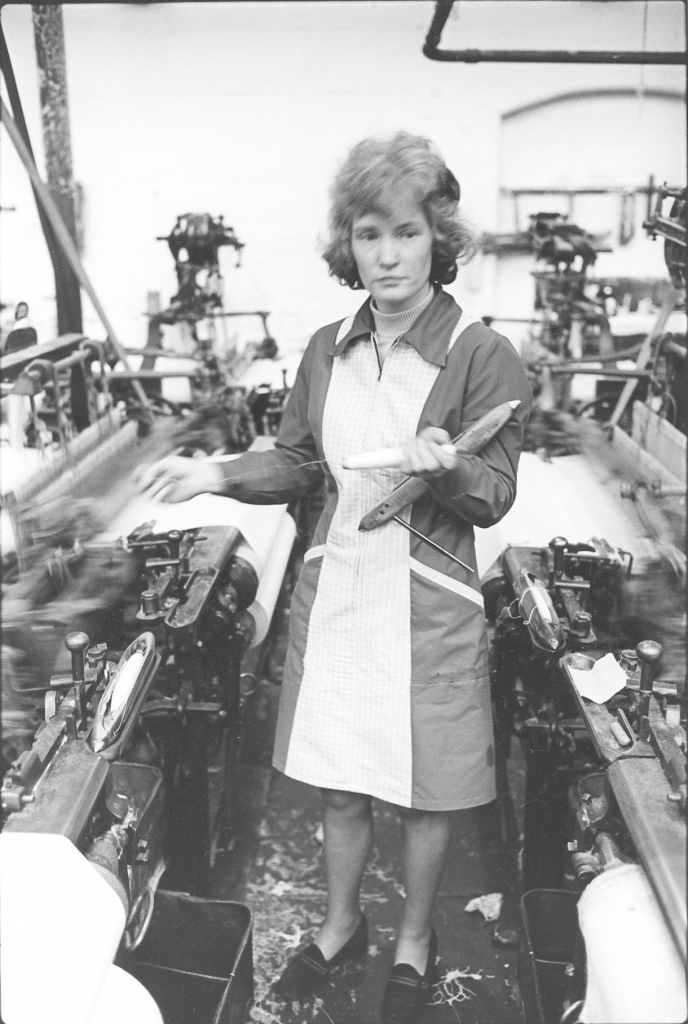
R – Well, I’ve got me shuttle tucked up under me arm again. I’m doing basically what I was doing on the other picture only it's a more forward view. Pulling weft off, cleaning the bottom of the pirn.
Yes. Now these shuttles that are an the loom here are full. Why is that a full shuttle? That probably sounds a silly question Mary, but I want you to tell me why you've got a full shuttle on that ... what do you call that tray anyway?
(200)
R - Shuttle rest.
Shuttle rest. Now why is there a full shuttle in that shuttle rest there? You tell me.
R – Well, its common sense. You've two shuttles to a loom, you have one in your loom running so you have one filled ready for when your other one's empty. Your loom stops, you can take one straight out and the other one straight in without wasting much time.
That’s it.
R - And then you fill your .. like I'm doing on the picture, fill the other shuttle.
Have there been times at Bancroft when either you or other people have had to weave with one shuttle?
R – Yes, many a time. Aye. You take 'em to the tackler and he is busy doing something then you've got to weave with one shuttle till he fetches it back. Or in the case of Bancroft, you had to go and fetch your own.
Aye, that’s it. What went wrong with the shuttles mainly Mary?
R- Oh, pegs breaking. The pegs you put your shuttle, your pirn on breaking, they split, quite often split, or chipped, chipped wood coming out of them. Wooden pegs coming out and clips, what they call clips that hold your pirn in when you put your pirn on ... Oh I'm describing … You put your pirn on your shuttle peg with some clips at the bottom that hold your pirn in place so that when the loom's running your pirn isn’t slipping up and down, it stays put. They have to be replaced quite often, they wear, that's most of things you know.
I've seen Ernie altering the shape of shuttles when they've run for a bit, do they go out of shape as well? You know, I've seen him sanding, and…
(10 min)
R – Well, they get rough. You know, they get rough edges. It your shuttle's rubbing somewhere in your box, if the box in not just right and it catches your shuttle in a certain part they will rub, and it's up to the tackler then, either to make the box right so as it doesn't rub, and then at the same time smooth your shuttles out.
Yes. Now your tackler was the man, the tackler, the overlooker, is the man that you went to if you had anything wrong with your loom wasn’t he. But there were certain jobs that you did for yourself weren't there, on the loom, what were they Mary?
(250)
R- Oh you mean like putting leathers on?
Yes.
R - You used to put your own short leathers on, and picking bands ... what else were there up at Bancroft? That's all there were up at Bancroft. short leathers, picking bands. But down at Johnson’s you'd to put your own check strap on, which you didn't have to do at Bancroft. Tacklers put those on. Butt most of, things like .. short leathers and picking bands.
Aye. That’s it. When you say check straps, that isn't the long one that runs…
R – That’s the long one that runs right across the front of the shed, yes.
The long leather, aye. And did you have to put those on as well?
R - At Johnson's. Yes
Aye.
R - But you shouldn't have to really.
Right, we’ll go on to .. wait a minute, picture number 3. Oh now, on picture number 3, on the floor by your right foot…
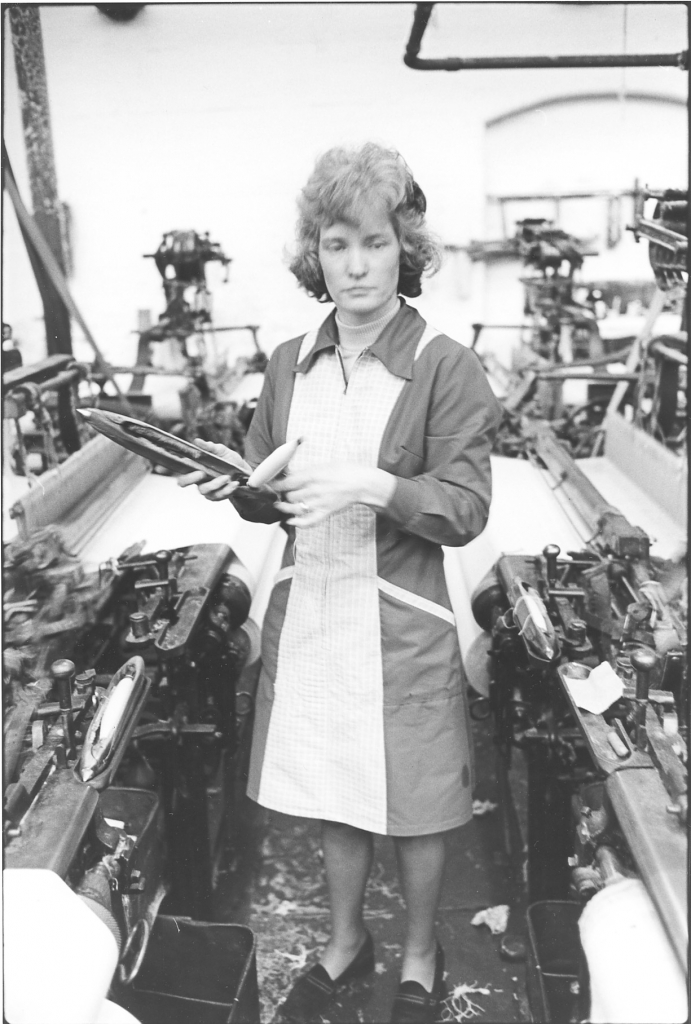
R - Yes ...
What's that Mary?
R- That’s an empty tin I used to throw my empty bobbins in. I used to take one bobbin off and chuck it in, and got another one out. And then ...
Yes. When you've got, when you’ve filled that tin with empty bobbins, what did you do with it, did somebody come for it or ..
R - No such luck! You had to go and take away yourself. Oh no, I’m telling fibs, sometimes Frank’d come round for them.
Aye. If you were short of pirns.
R - Yes, we had to be short of pirns. But more often than not you'd take them back yourself. I used to take them back in at first thing in the morning. Like I were telling you last week, I used to come to work soon and get meself straightened out and that were one of the jobs I did, take the empty bobbins back.
Yes. Now, you wouldn't be walking about a lot there. How many of those tins did you have about in your alley? I see there's two there, isn't there. There is one at either side there.
R - Well there'd be, there'd be one for each … how many would I have? Two, four, six I think.
Aye, one for each pair of looms and then an extra one for the end. Yes.
R - Two pairs of looms yes and a single one at th’end yes.
What's this on your left hand side, that shuttle tray there, what's that white thing that's laying on ...
R- That looks like sandpaper.
Aye. What would you use that for, Mary?
R- Rubbing your shuttles. You know, if you got, if the shuttle's got a bit rough.
Yes, so you'd do a bit on your shuttle as well. Have you ever put fur in your own shuttle?
(300)
R - I have, yes. Yes it's easy enough to do.
Yes, I have a picture of Mary Cawdray doing it.
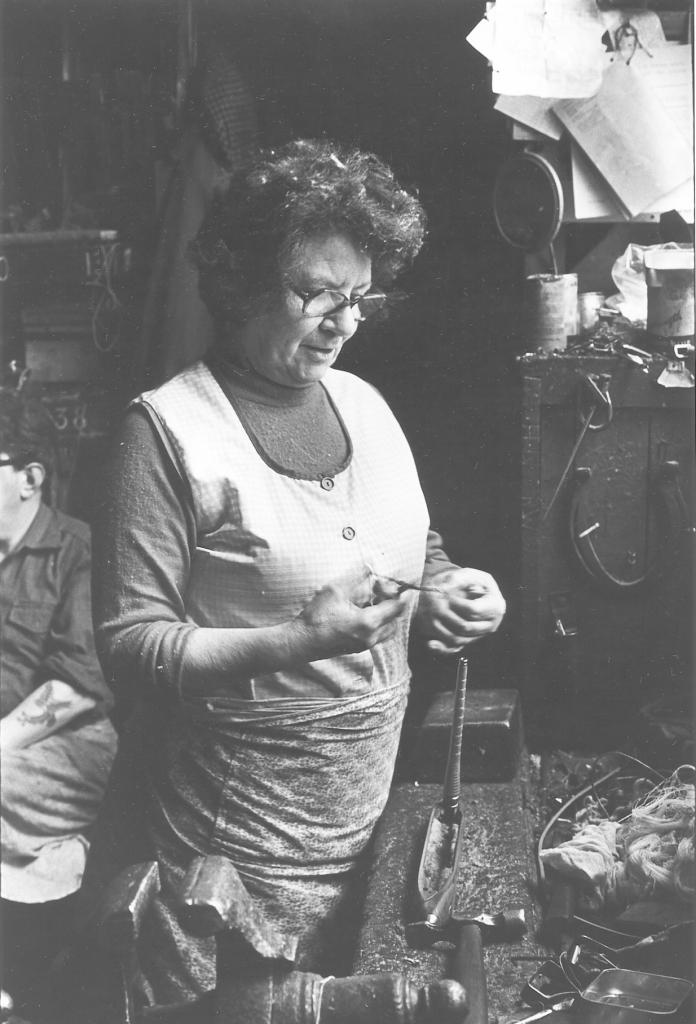
Mary Cawdray putting fur in one of her shuttles.
R- I never did it up at Bancroft though, I don't know, I stuck a bit down odd times. You know, when it comes loose. Yes, odd times.
Yes, if it was lifting. Aye.
R - It looks like I've got a warp out on that loom.
Ah, what makes you may that?
R- Well, there’s no cloth over the bearers.
That's it, aye,
R - There is rollers there waiting to be taken out.
Yea. What did you call this front?
R - That was the breast beam, breast beam, yes.
Breast beam, that's it. Aye.
R - I don't know [the names of] half the things meself to tell you the truth ... I think it's the breast beam.
No it's right, I just want to know what you do know, it doesn't matter. I mean you know more than I do about weaving. Anyway, picture number 3. Now we are one stage further on, aren't we and .. What are you doing there? We are one stage further on in the process.
R- One stage on. I've caught the pirn on the shuttle peg, I’m finding the end. Yes, I'm finding the end, the loose end.
And not even looking at it?
R - No I'm not even looking at it. I must be watching somebody else, there must be something interesting happening there. And then I would close the shuttle down and thread it.
Yes that's it. Well now, on picture number 4 you have .. you see you were moving that quickly you see, you shut that, you've shut that shuttle up and your hand’s a moving that quick you’ve lost me completely, it's a blur is that shuttle.
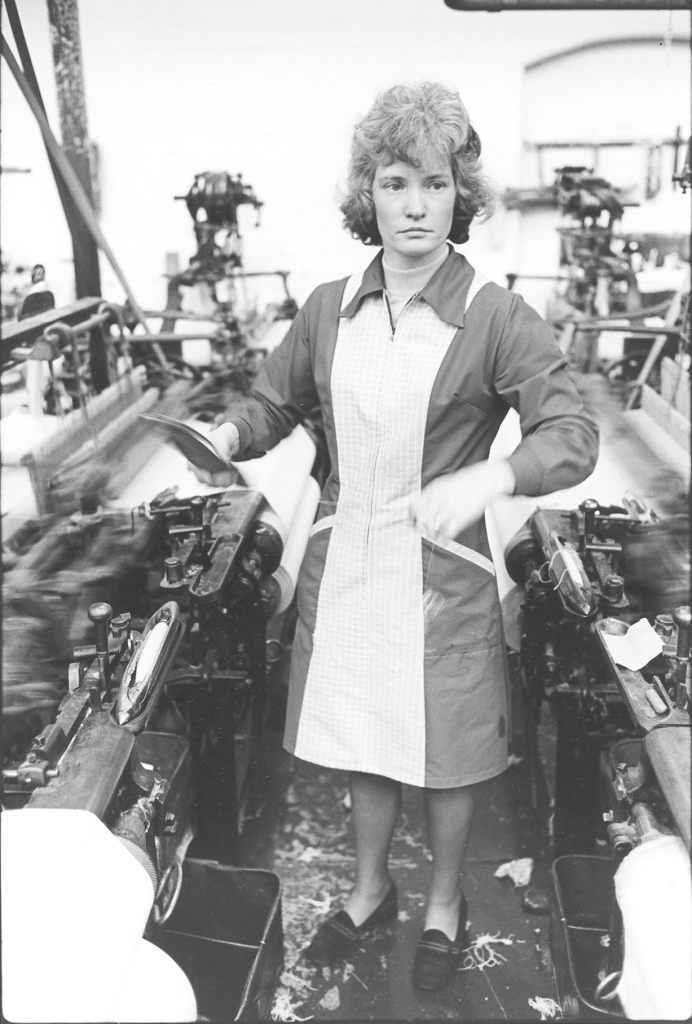
R – Yes, well as you could see it's a follow on from number 3, I've closed my shuttle up ...
Yes and see, your hand's just flying out. Well it looks as if you are going to put it on that tray just behind you aren't you?
R- Yes, that’ll, that's where it will be going, yes.
Yes. On your right hand-side. Anyway, number 5.
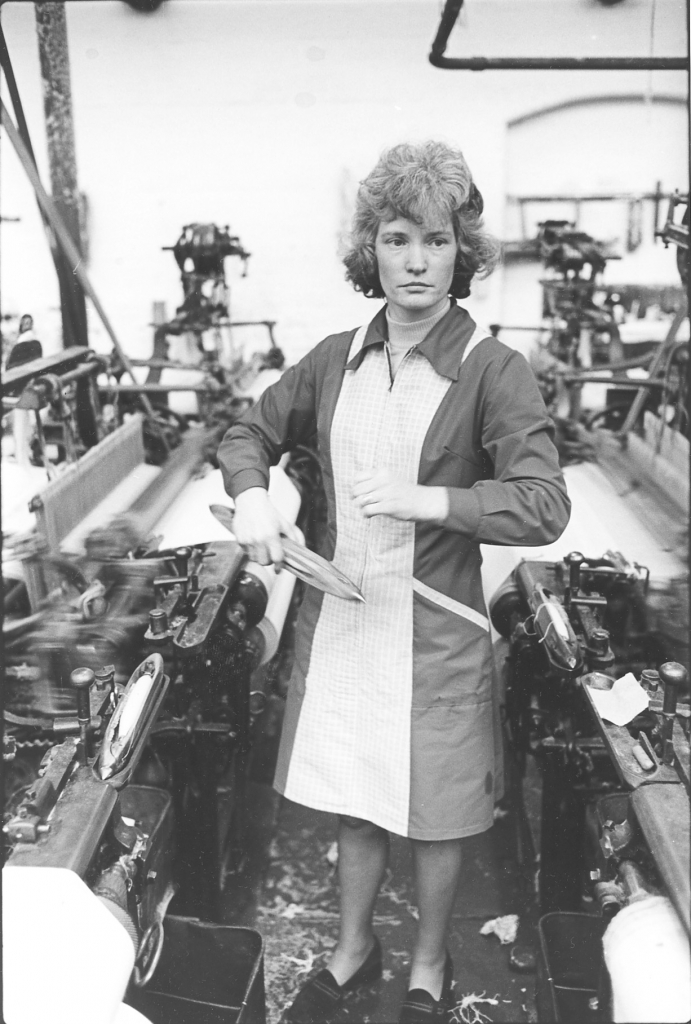
R- Yes, I still have …
Yes. You’ve still got hold of it but, ah, you were drawing a bit of thread out through the eye on the other one weren't you? And now are you wrapping it round there?
R- Yes that looks like what I’m doing. It looks like I'm wrapping round me shuttle yes, and then as you move to number six I'm putting it down.
Yes. Number six you are putting it down. And that’s actually, that’s one pirn changed ... Now, how many times would you do that in a day Mary?
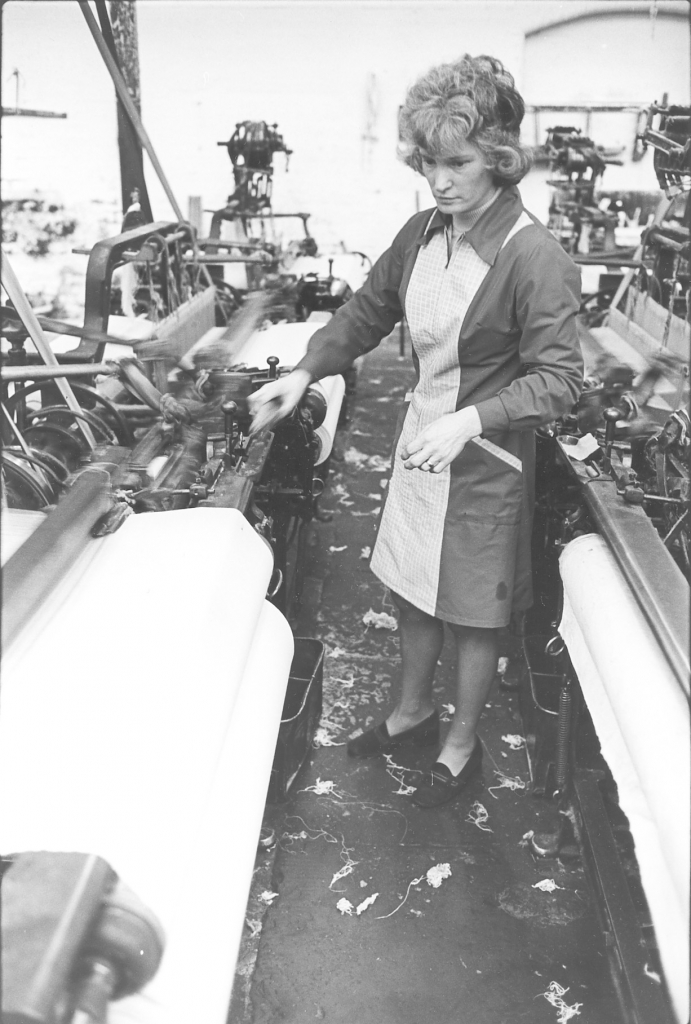
R - Oh heck, hard to say ... hundreds I would imagine. Because I mean, you get all these thick wefters, they don't last above two minutes. Like condensers, eights weft you'd be for ever at it.
{We keep coming across counts of weft like ‘eights’. The count of the weft is the number of hanks of weft to the pound. A hank {or in old terminology, a ‘lea’} is 840 yards. So the lower the number, the thicker the weft. Eights was heavy weft. In 1851, Gilbert J French, the Secretary of the Bolton Commissioners Committee was presented with samples of yarn spun in Bolton Parish to a count of 700 hanks to the pound. This was incredibly fine weft. At Bancroft we used 44s regularly and sometimes 60s but not very often. Obviously, the finer the yarn, the finer the cloth.]
(350)
Yes. So I mean you've got eight looms, so if you ….
R – Ten. Ten.
Ten looms rather, so if you reckon average of say six minutes, because that is what it’d be about wouldn't it, taking the rough with the smooth would it?
R – That’d be with the thick and fine wefters, yes.
Yes. So if you weren't doing so badly, if you had a few condensers in, put a few 44's and all ... say every six minutes, that's ten looms, that's .. that's a hundred in an hour, that’s eight hundred a day isn’t it.
R- It's a lot yes.
So you're doing that on an average eight hundred times a day, sometimes
a bit less but very often more.
R - A bit more. On an average, I had ten looms, I had eight thick wefters in more often than not. I had more ...
Eight thick wefters in, aye.
R - Seven or eight, yes. Because I used to prefer them and Jim used to let me have ‘em.
Ah well, he knew you could roll it off, didn't he? So you'd be, if you had eight thick wefters in, that's eight loom, you had to take in thirty shuttles an hour, that's two hundred and forty an hour. And say the other two, that's three hundred an hour that's …
R – You make it sound like hard work.
Aye, three hundred an hour times eight, that's, Good God, that's two thousand four hundred a day.
R- I don’t believe it. It's a lot I know, it must be.
Aye, but if you had eight thick wefters in, that's what you were doing.
R - But all you have to do really is count all your pirns up.
Aye, two thousand changes a day. Tha must be, tha must be going some Mary.
R- Must be.
Yes. Bancroft shed, nicely whitewashed in your corner.
R - Oh yes, you couldn’t see the green mould coming through the wall.
Yes. Now go on, tell me, what makes you say that?
R – Well, it used to be green didn't it? The damp coming off, through the field outside.
Yea. That wall, in fact…
Well, you could see it there, you can see it on picture number 6 in one corner there.
Yes, you can see a patch on the wall, can't you. There was mould coming through that wall because it was, because it was damp outside. And also your side of the shed was the coldest side wasn't it.
R- Oh it were, about ten degree below everybody else in Winter.
Aye, it was, you're quite right.
R - And Dorothy and me were the only ones that never complained really. We used to get, we used to get woollies on, and do some soup and carry on working. That's all you could do, you had to work to keep warm.
Yes aye. Yes but that's a different attitude Mary than a lot of people would have nowadays about…
(400)
R- Oh true, they wouldn't do it these days.
Conditions like that. Because I mean, I've seen you weaving there when the temperature's been below fifty and forty-five .. you know between forty-five and fifty.
R- Oh at Bancroft if your temperature were in the sixties you were warm. You were warm you know?
Yes. And yet the regulations said it had to be sixty, aye.
R- Sixty, yes.
Would you say, really, that old fashioned type Lancashire weaving like you were doing there, like with thick wefters and you were moving about all the time, would you say that sixty degree was too warm for comfort?
R - Oh no. No. It's all right. It were all right for me, it didn't bother me, but some people, it's a bit cold for ‘em. For a lot of people it were too cold.
Oh yes. Well, as you well know, I did have my little troubles about that, with some people being warm and some people being cold. Aye. When you swept your waste up in the bottom, because obviously, from the look of the floor this must be getting on towards dinner time and it's not…
(20 min)
I must have taken that other picture of you fairly early in the morning or just after dinner. When you swept your waste up, what did you do with it Mary?
R- You just sweep it out in the alley and up the side of a pole [a pillar] you know. Then the sweeper'd come round and pick it up at night. You sweep it to one side like.
Yes. That went for waste. Now what about .. that went out not as cotton waste, that just went out as rubbish didn't it, sweepings.
R – Yes, rubbish yes. [‘Sweeps’ as this rubbish was called was actually quite dangerous. Because it was dirty and damp ands contaminated by oil it was prone to spontaneous combustion. As it heated in the normal way, it became quite offensive. At Bancroft it was stored in the old air-raid shelter on the side of the dam as this was a brick and concrete structure separate from the mill and was therefore safe. When a wagon load had accumulated a contractor came in and removed it as rubbish.]
Now how about waste that you used to take in the warehouse and put in the bag in the warehouse? Where did that come from?
R- Well, it’d be what you pulled off. You put some in, they’d have like tins on't floor. You put your weft in there. I didn’t do a right lot. I didn't do a right lot of that be the looks of it at Bancroft, most of it’s on the floor. But sometimes like you get a weft, a pirn that was soft, and all the lot would fly off then. Obviously you wouldn't put that on the floor, things like that you'd take back [as waste for recycling]
Now then, tell me more about that. You say a pirn that's soft, what do you mean by that.
R - Well, it’s been wound soft, and if it's too soft, you can feel they're soft.
Yes, in other words its not being wound tightly enough.
(450)
R- Tight enough, no. And sometimes they weave off all right but more often than not your whole cop would fly off. Sometimes you get away with it, your loom 'd just stop, and sometimes you could make a right mess, make a right mess.
Yes now when you say the whole cop flies off, what’d happen, the yarn package itself would slide off the pirn, jam up in the shuttle, and your weft’d break. How could that make a right mess Mary?
R – Well, sometimes they fly off, they could fly off over the top of your shuttle and get fast in the shed. And then it’d drag. You see, your shuttle’s going, it’d drag and get fast as your looms coming over and it could fetch ...
Ah, I see, your shuttle’d never pick properly with the, with the drag it wouldn't pick.
R- No. It wouldn't pick properly you see and as your loom's coming over, if they're getting fast, it’ll get fast and drag more, therefore you have to have a mess. You could have half a warp out if you are unlucky enough. [Half the ends in the warp broken. This is a smash, not a trap.]
How many times did that happen Mary? You know, how common was it for you to have a, you know, like a bad smash?
R- Oh, it depends on your loom and it depends on the weaver I suppose. A lot of weavers had smashes because they just set the loom on, they didn't bother to make sure the shuttle were in the box right. If your shuttle is not in the box right you can have a mess there. And as I was saying last week, you can have things go wrong with your loom, things like that you know. I didn’t have all that many I don't think really. But, if you, generally if you try and keep on top of things like your pickers and your short leathers and picking bands, them type of things that can cause smashes, you can usually, you know, you keep yourself pretty straight.
How important is oiling, you know, in things like that?
R - Oh it is important to have your looms oiled, that’s why your loom should be swept every week and oiled every week. I were lucky that Bancroft had a good sweeper.
Who swept for you?
R – Leslie, what were his last name? [Lambert]
Yes, little Leslie, aye.
R - Yes, can't think of his last name, Anyway like I say I were lucky I had a good sweeper and they were swept and oiled regular. Because if they don't get swept and oiled regular they can seize up, and you can also have a fire, because of all the dawn that collects, especially on some sorts, which are muckier than others [sorts of cloth]
Yes. Did you ever see a fire at Bancroft?
(500)
R - Oh well, yes. When Fred Roberts had one. That's .. oh, funny were that.
Tell me about it.
R- It were just after dinner, I wonder how I remember it. We just set on after dinner, and we were working and all of a sudden the fire alarm went. Nearly made us jump out of us, jump out of me skin. We looked round and there was Fred Roberts running up and down like somebody demented, there were a lot of smoke coming off one loom and everybody else running about. But funny part were none of the weavers moved, they all carried on working, the mill could have been on fire but nobody moved. And there was, and Ernie, not Ernie Roberts, Ernie Whitaker walking about with his teapot full of water to put the fire out .. oh that were right funny.
Oh yes I remember that bit.
R - There were no fire extinguishers you know, in t’shed.
There were two.
R- Oh well there were none near me.
There were two powder extinguishers, aye that's it, there were only two, you are right.
R - Yes. There were none round there.
It was something which I got on to them about. I got on Jim time and time again because those two that were in the middle of the shed, actually, were for electrical fires. They weren't water extinguishers, which they should have been, no.
R - They weren't water, no.
(25 min)
And the funniest thing about that day, I’m glad you brought that up because I don't know whether I have this on tape or not. Was the fact that, you know, I was running the engine, and the fire alarm went off and when the fire alarm goes off it rings a bell in the engine house you see. And .. I mean, what I should have done immediately was stop the engine and go and see what was wrong. But what I did, I thought to meself “Hello, some silly bugger's put a beam pike through t'fire alarm.” And I walk quietly up the side of the engine and got a spare glass and screw driver and key for
the fire alarm, you know. And I walked quietly up into the shed and when I got into the shed first thing I saw was Billy, Billy Two Rivers ..
R- Billy Lambert.
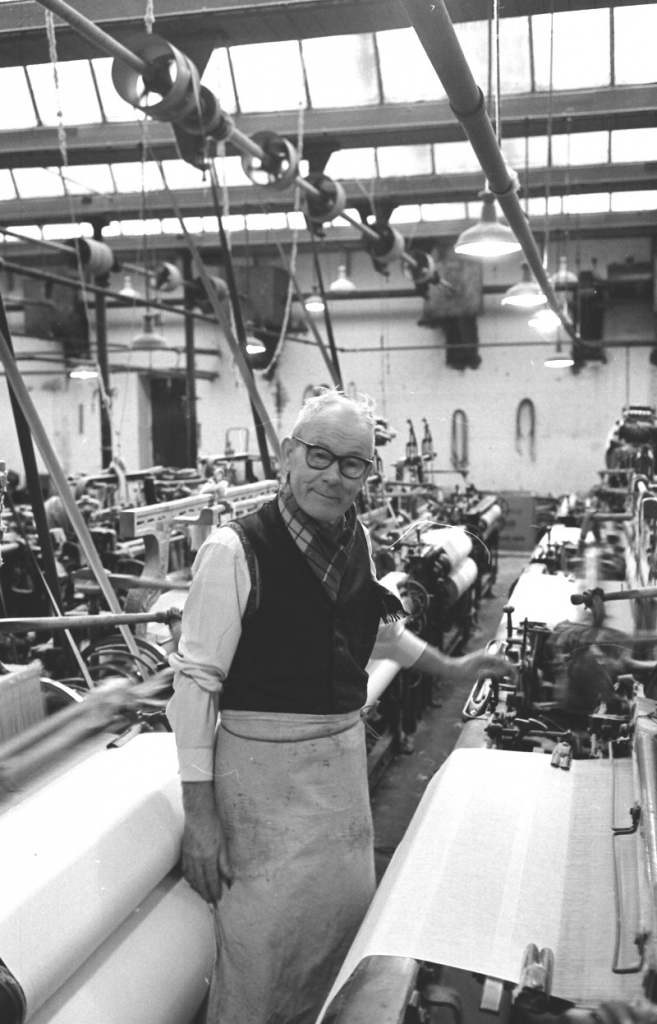
Billy Lambert stood with the hammer next to the stop button for the engine. As I walked through the door he says “Have I to break it?” I said “You’d better not, I haven't got any spare glasses for that! What's up?” He says “Mill’s on fire!” I says Nay, bloody hell! But by the time I got there, Ernie with his teapot had put it out. But I thought afterwards. How silly!
R- It were silly.
I was as bad as anybody else, I heard the fire alarm go off, and you know, it meant there was a fire. but I thought straight away, I thought some tackler would be walking round with a roller over his shoulder you know, sommat and bang through the fire alarm because it's happened before.
R- You see, up at Bancroft they never had fire drill.
No. Do they have fire drill at Johnson’s?
R – Yes, they have fire drill and not that long since down at Johnson’s.
Do you know how often it’s going to happen?
R- No, no but they let us know when it happens. Like they told us what was going to happen and what we had to do you know? But like up at Bancroft they were, we just kept on working.
(550)
Aye ... No, I’m glad you brought that up Mary.
R- It were funny were that.
Yes, aye, Yes. Right, we’ll go on to number…
R- Ernest and his teapot.
Aye, Ernie Whitaker and the teapot. I can remember that, aye. And he put the fire out.
R - Oh he did, mind there weren't much to put out like but ...
And nobody ever knew how it started.
R - Looms that hadn't been oiled, that's what it were.
Aye well, here you are. Picture number 7.
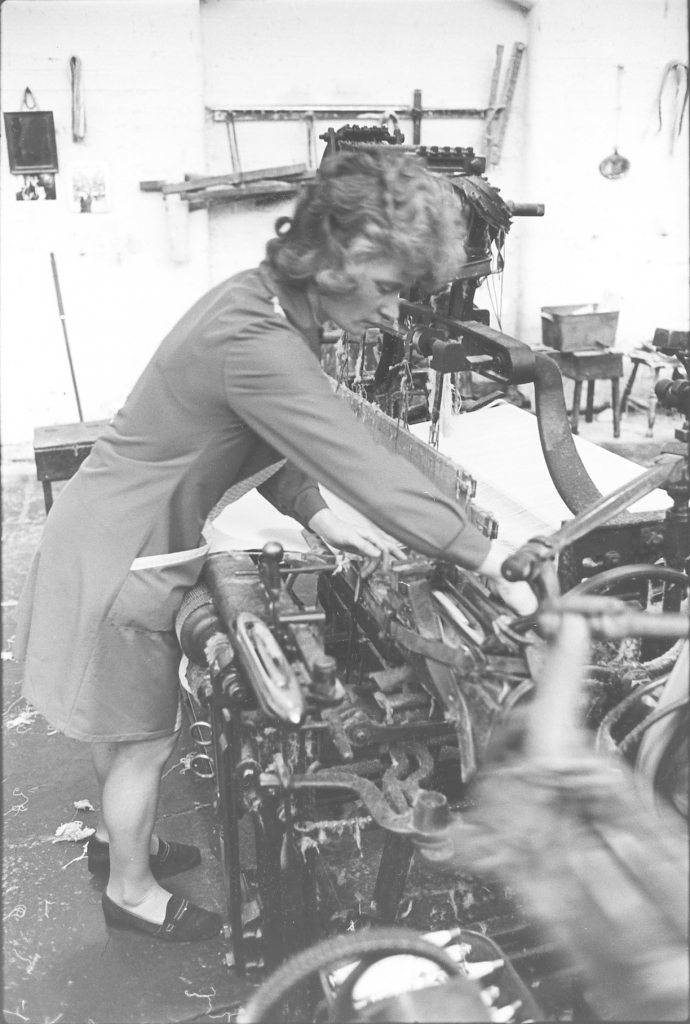
R - Picture 7, yes. Yes, I'm putting a shuttle in, pushing it up, right up into the box, make sure your shuttle’s in, right in the box else as I’m saying you can have a mess.
Yes, Now, one thing about that .. your right hand, what are you doing with your right hand there Mary, you've got it behind the box haven't you?
R – Yes. Well that loom is a bang up, it’s what they call a bang up loom. Now every box has a swell on the back of the box, what they call a swell. Now on these bang up looms it helps you to get your shuttle in, it gets easier for you if you can open your swell, which you can do on these bang up looms, which you’ve no need to do on ordinary looms that are loose reed looms. See, a bang up isn't a loose reed, and like I say it helps you to get your shuttle in. Probably you can do it on your others if you want like but I only did it on bang ups. Made it easier to get your shuttle in. But there, I'm not using a pirn there you see, I'm just using me fingers. [Bang up looms weren't common in Barlick, they were useful because if necessary you could weave very heavy cloth on them, up to canvas weight. We never did any so heavy but occasionally Queen Street at Harle Syke would send us warps to weave because they had no bang ups. I seem to remember that when we finished they bought the bang up looms off us because they were still weaving.]
No, you're using your finger aye. Yes I noticed that. And .. yes, and there is your empty shuttle.
R- Yes …out.
Now, there's a thing ...
R- What?
Oh, of course, you can’t see the cloth, it looked as if that sand roller was empty, but it can't be, it's just the end of it.
R – No. Just the end of it yes.
Yes. When you were leaning up against that, because that sand roller’s covered with spiky metal isn’t it. Metal that's made like a nutmeg grater. It's punched from the back and it’s spiky, did it use to wear your clothes out, leaning on the loom, up against them.
R- Yes, I used to tear my overalls yes, wear me pocket's out, yea.
Yes aye. And so there, that loom's stopped. Now, when a loom stops does it always stop in the position that's right to put the shuttle in?
R- No, you have, very often not and you have to move it. Sometimes it’ll, sometimes it'll stop with it back at the right end and sometimes it'll come over. Sometimes it stops at the wrong side. It's called, it stops at the wrong side. If your shuttle stops at the opposite side to what it should, it should be at the starting side.
(600)
Yes. Now it should stop on the same side as your setting on lever shouldn’t it?
R- Yes, yes. Same side as your starting handle, yes. Which is that thing.
Yes, that’s it, yes. And .. something I've noticed .. tell me why when you were putting a shuttle in, you didn't just put that shuttle in at one end and let it start, you used to many a time slip it in the middle of a warp, now why was that Mary?
R - That were called ‘finding your pick’. Now up at Bancroft there were pickfinders and non pickfinders. With a pick-finder you had to find your pick. Which if your shuttle is going backward and forward it is putting a pick in every time your shuttle goes across it is putting a pick in. Sometimes your pick were loose when you change your shuttle which in that case you just put your shuttle in where your pick, where your weft finished. Whereas if your loom, if the pick was fast you’d have to turn your loom over to find the pick.
Yes. Let me just see if I've get that right, then other people will get it right when they’re listening to you. No, you described it very well but the thing is when you say the pick was loose, that's if the shed hasn't altered after the shuttle's gone through isn't it, and trapped the pick that's just gone through.
R - Yes your shuttle, if it's .. your shuttle, your loom stopped when your shuttle’s empty. As it's .. I don't know how to describe it really.
No, you are doing all right. If your loom's carried on, if your loom hasn't stopped straight away, say if the brake wasn't very good and it hasn't stopped straight away it's possible for the shed to alter and the last, because the last piece of weft that was coming off the shuttle can be trapped in the shed can't it?
R - A lot depends on where your weft is when it runs out, when your shuttle runs out. If it runs off when your shuttle's going to your off side away from your starting side .. then when your shuttle comes back, your shuttle will automatically come back till the loom turns over and come back. Now that pick will be fast.
Yes, that's it.
R- Now then, I would have to find that pick, that would mean turning me loom over and finding that pick and then putting the shuttle in.
Yes. So you turn it over until the shed was open again on that pick.
R – Yes..
So if it's a pick-finder you've always got to start .. so that in effect, if you were to tie them two pieces together in a knot, it'd just be the same as if it’d gone straight through. But if it wasn't a pick-finder it wouldn’t matter whether your pick was fast or loose.
(650)
R - It didn't matter, no, you could just throw your shuttle in and ...
Yes. What were them, things like gauzes and cheaper clothe and what not?
R - Yes. Like down at Johnson’s, there's no pick-finders down there. I suppose a lot depended on what it were used for, what .. like you say, cheaper end I suppose. Things like one reds and them, they weren't pick-finders. A lot of condensers were pickfinders. So you throw your, throw your shuttle in then and you'd let your loom back, let your wheels back.
Yea. Now why do you let your wheels back?
R- You'd to let your wheels back or else you'd have a thin place. They’re like, they're like a gap, so to say between your shuttle emptying and setting your loom on again.
Yes. In other words the cloth roller has wound on a little bit and pulled a bit of cloth through when it had not been really weaving. So you just reached to the side where the gears are and lift a pawl and let it off.
R - Perhaps let two or three you know?
Yes. Now, did you always let it off the same for every cloth or …
R - No, no. Like some of them you didn't need to, the strong ones, the very strong ones you didn't need to let back. Some you let more than others, some you let back a lot like condensers.
And how did you know how much to let it back Mary?
R – Well, it's what every weaver gets to know with her own looms. She gets to know just how many teeth to let back on each loom for each sort. I mean, I could, let's say let two back on one of mine for one particular sort and go to somebody else’s alley for the same sort and they might not want any letting back or a lot it just depends on how it's, how it is you see?
So it was important really that you were an the same set of looms all the time. It was easier for you it you were on the same set of looms.
R - Oh it's definitely easier if you've got your own looms yes. I mean you get to know how them looms are and what's what with them so to speak.
That's it yes. Now then, picture number 8, what are you doing there?
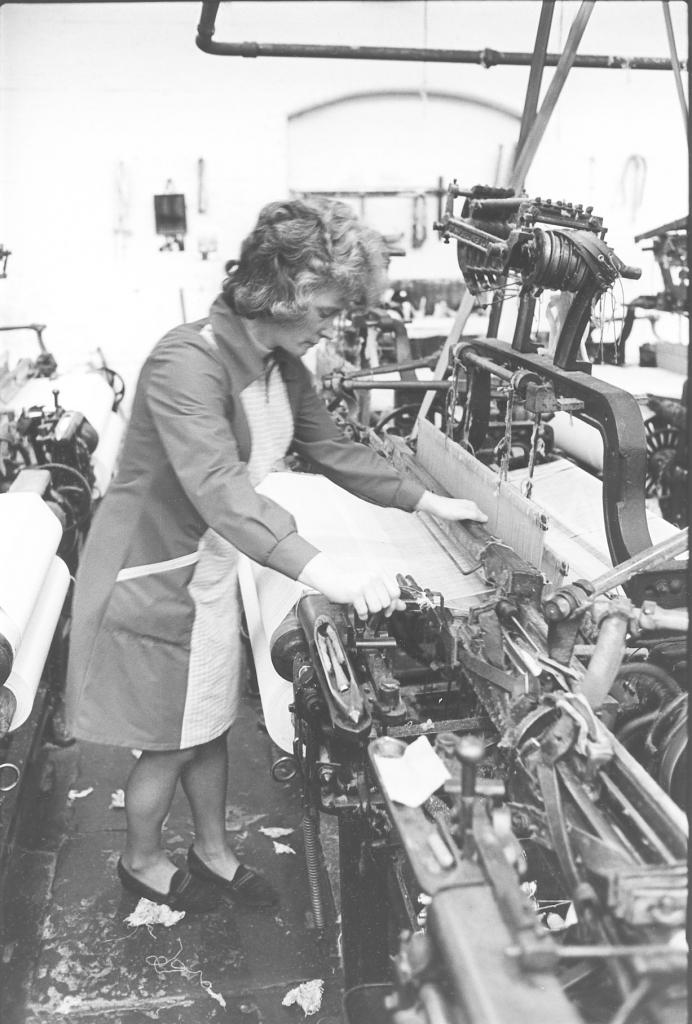
(35 min)
R - Picture number 8. I’ve put my shuttle in, and I’m about to set me loom on. I've got my right hand on the starting handle and the left hand on the hand rail so that when I set me loom on, I set me loom on and pull me loom over. Which .. It shouldn’t, you've no need to do really, it's just habit is that. I had to do it on quite a few looms at Bancroft, the heavy ones you know, like bang ups, for if you didn’t help a bang up over sometimes it would, it just wouldn’t run. But .. like I say a lot of it is just habit, setting your loom on and pushing your hand on the hand rail.
Aye, that's why the hand shelf always got polished didn't it.
R – Yes, well worn.
Well worn, that’s it, aye. Just underneath your hand where it’s an the hand rail there, hand shelf, slay cap, whatever you want to call it, there's a metal bar running across the top of the warp. What's that Mary?
R- That's your shuttle guard.
(700)
That’s supposed to stop your shuttle from flying out. That's what it’s for. It didn't have much effect.
New then, you say it's supposed to and it didn't have much effect. Did you ever have a shuttle fly out?
R - Oh yes. They flew out. They're dangerous.
Well they are, I think somebody got hit in the eye while I was there, with a shuttle.
R - Yes. Because they are fairly moving when they come out. You can't see ‘em coming out, they've gone a long way before you know where they are, and they go for yards you know, you'd be looking for them in your alley and they can be away, way away, over in somebody else's alley.
Aye, when you come to think it’s…
R - It can be dangerous, it is.
Aye. And have you ever seen a shuttle guard that worked.
R - Well, I suppose they do work most of the time. It's just .. when your loom goes wrong, if it’s not picking right I suppose it just, it just flies out and that's it you know? They aren't really much. I don’t know if they really are much of a guard really. I suppose they must serve a purpose. Well, that's what it is. It is a shuttle guard.
Now, what was I going to say? No, you've answered me question there Mary. You are doing very well actually. Now, this loom that you are on with there, it's got .. in front of your head there, this arrangement of pulleys and leather straps and what not. Now tell me what that is.
R - That's what they call a spring top.
And what’s that for Mary?
R - They use them for twills, we used to have twills in.
Now, this that you've got in there is a two stave isn't it from the look of it.
R – Yes a two shaft, yes.
How many shafts would twills have?
R - Four. Well, them what they had up at Bancroft they're four shafts. Yes. They'd be me reds. A two shaft had four healds ...I can’t see, no, that's only a two.
That’s only got two, yes.
R - That's a two, yes. That's only a two shaft.
Yes but, Ernie went into that .. using four shafts as two shafts, you know. I mean two healds running together and having them slated, he went into that fairly well. Why do they slate them, why do they do it that way?
R- I don't know, it depends, I don't know really See, a lot, the majority is what you call, it's two in a reed, two ends in one dent in your reed. Now there’ll be four shafts, slated as you call them. They’ll be plain but they'll be four shafts. So that'll be, like one, one end through, one dent'll have two ends off a front heald and a back heald. They're either ones or threes, or twos and fours on a plain one. You'll have
(750)
a one and a three off your healds, in one dent, and a two and a four shaft in your dent. That’s plain cloth; whereas this is just, on this picture number 8, is just a single shaft. Now, they'll only have one end in one dent, one end in a dent.
Yes, that’s it. That won’t be a very heavy cloth, will it that you are weaving there?
R - That's .. No, it'll be condenser cloth be the looks of it I think. I think that's what it is. Majority of condensers were one shaft. Yes, one in a dent.
What's that hung on the wall, just over your head.
R - There? That's a mirror.
Aye. What do you have a mirror for?
R – Don,t know, comb me hair.
I thought that might throw you Mary! Yes, I think we've done very well with that. Yes well on that, with that only being two staves. You are not using the spring top are you? You are using that, what do they call that across the front?
R - I haven't the foggiest idea what they call that.
Good lass, don't be frightened to say it if you don't know.
R - No I don’t. Those are dolly leathers that your healds are fastened on to, your heald bands are fastened.
Dolly leathers?
R - Those what your heald bands are fastened on to. But for that thing itself I have no idea what it’s called.
Good lass. And the heating system over your head. The Bancroft heating system specially designed for warming sparrows.
R - Oh yes. What am I doing here?
Now then, 9.
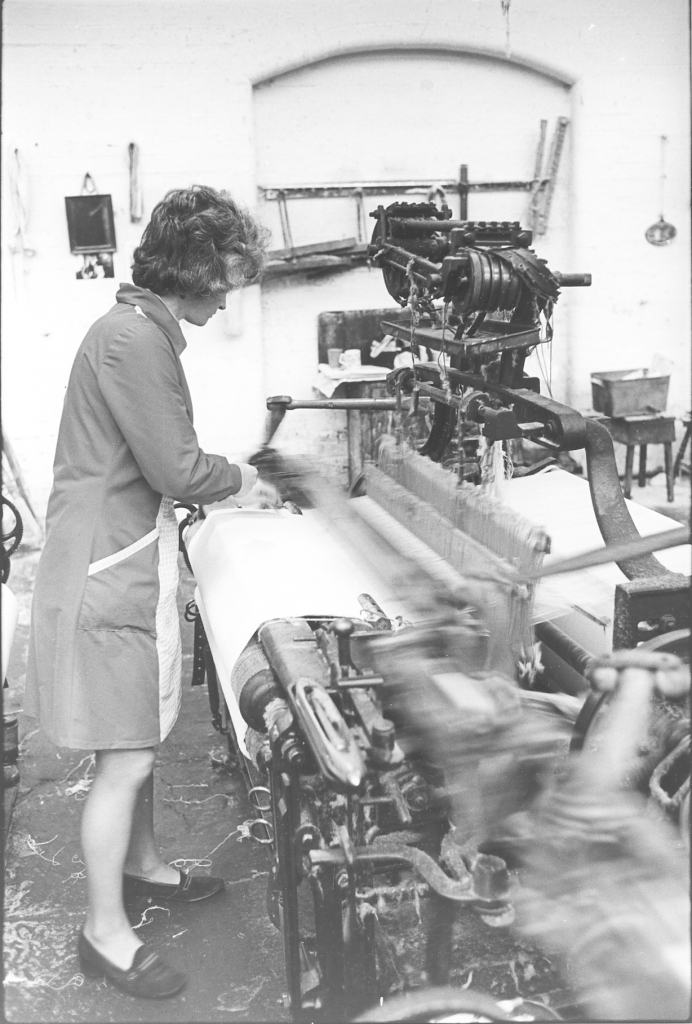
R - Oh, I've got me loom running. I'm breaking me tails off, which they're bits of end bits of weft, tail ends of weft. Which is your pick, presumably it's a pick-finder. I've pulled me pick out and thrown me shuttle in. I'm keeping hold of the end of the weft and it looks like I’m breaking them off. Yes, that's what I'm doing now.
Yes. There'll be two, there'll be the end of the old one and the tail of the new one that you’ve just put in. Now then, picture number 10 is, obviously it's a different loom, we are facing the other way. We’re facing up the shed now but this is another loom and you're just, now you tell me what you're doing on there, you're just putting the shuttle in.
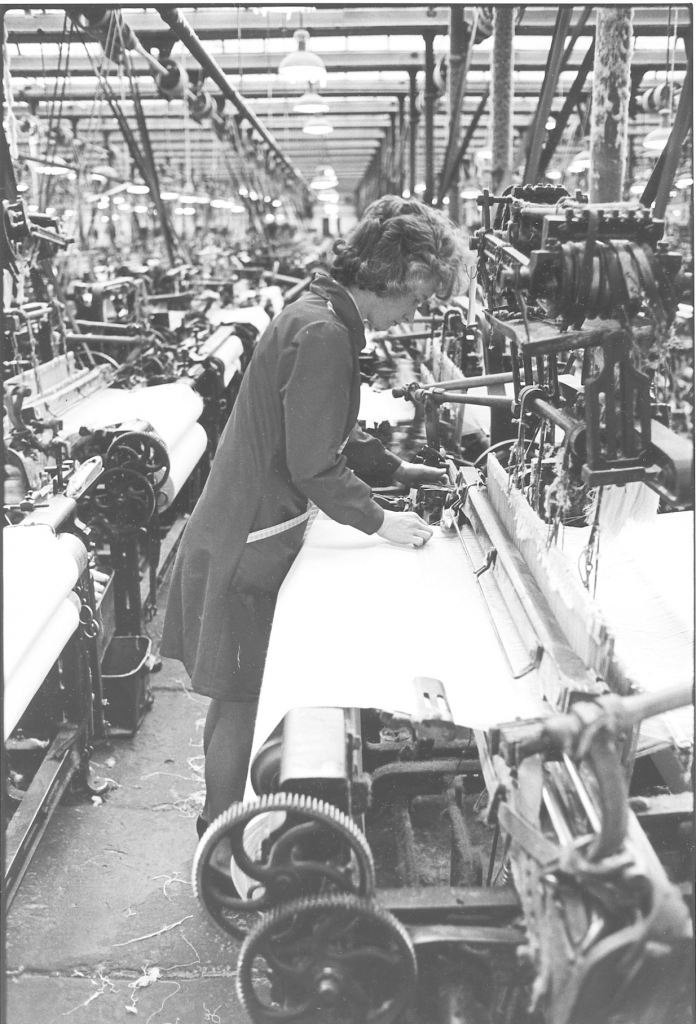
R - Putting me shuttle in yes.
And this is another shuttle change, but this one's in because something happened here. Now, before you go to number 11. Now what are you doing on number 11? You put your shuttle in and…
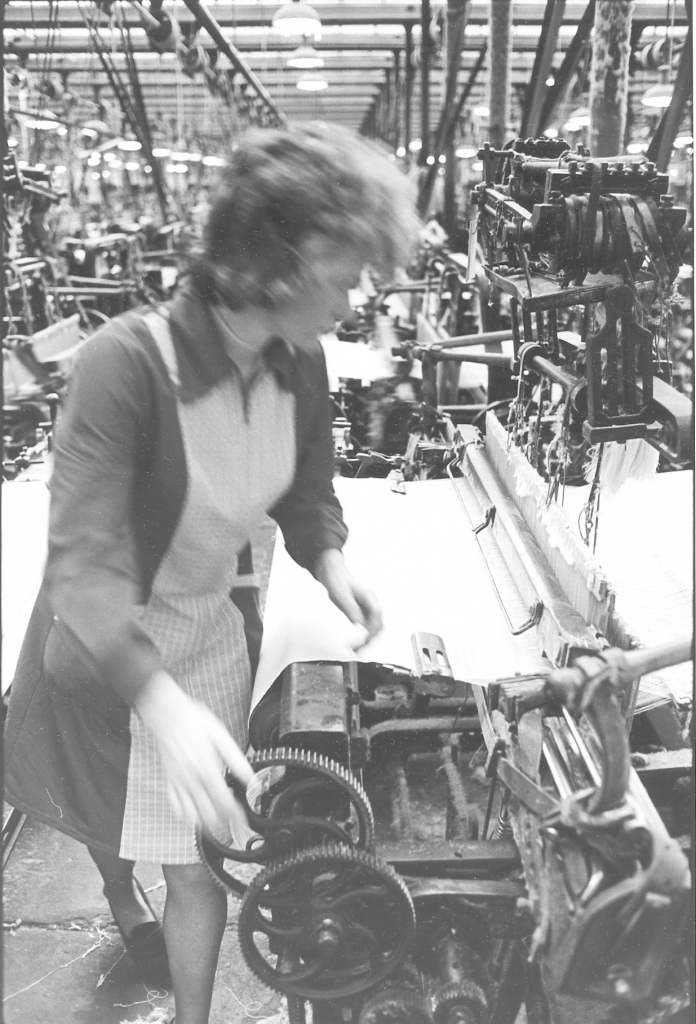
R - I'm putting the shuttle in, letting me wheel back ready for setting off.
Yes, now, on 11 there you'll get hold of that top wheel won't you.
R – No, this one, the bottom one yes.
The, the bottom wheel , and with your other band you'll lean over and lift…
R - Lift the two levers, that lever whatever they call 'em there.
Yes, the pawl, that's it, aye.
R- Pawl, yes. I lift them back, let back a couple of cogs.
Yes. And then set your loom on. Yes, now in 12 you've evidently set your loom on, your loom's running, and ...
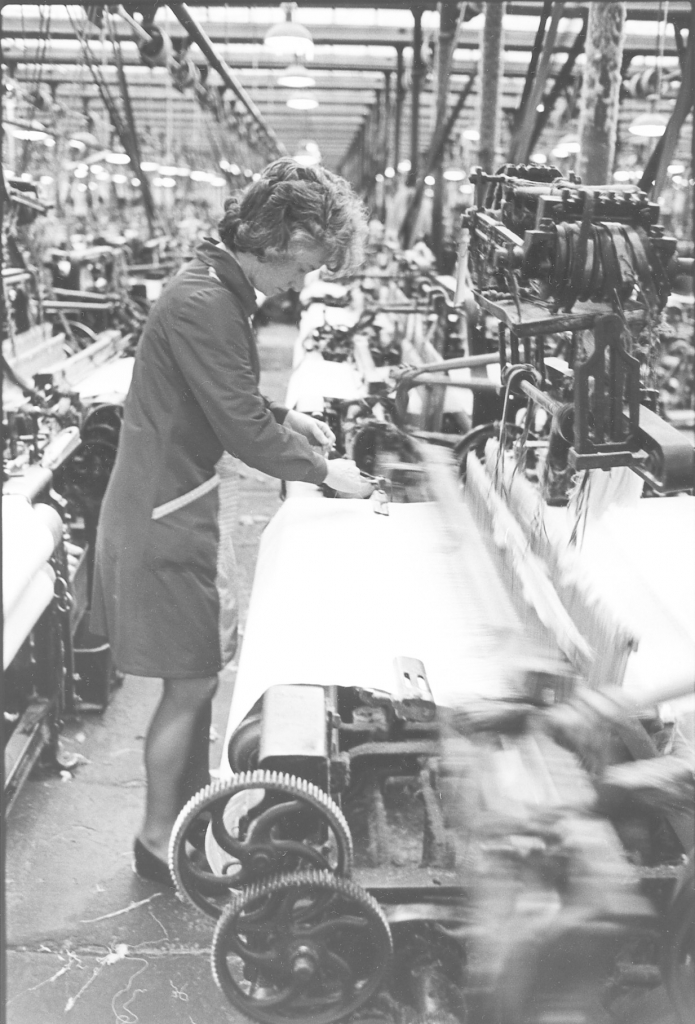
R - Yes. Pulling me tails off.
(800)
Yes you're pulling your tails off again.
R - Thirteen ...
On 13 you're changing your pirn aren't you?
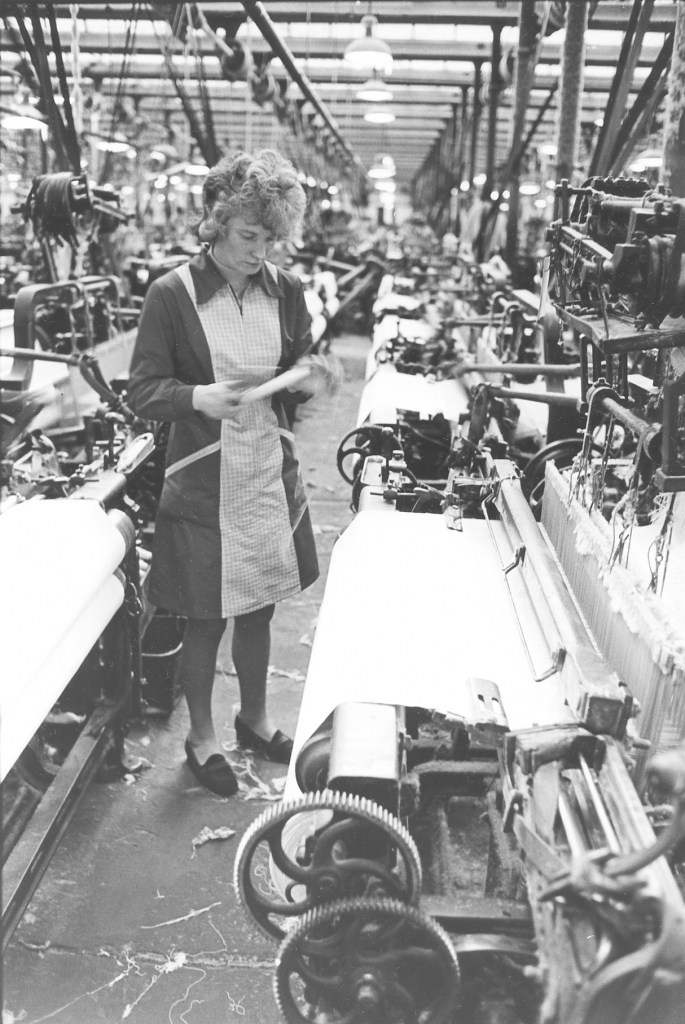
R – Yes, filling me shuttle up.
Filling your shuttle up. Now then, while you were doing that, that loom stopped by itself. And now we’ll go on to 14. Now you can see that you've filled your shuttle and put your shuttle down on the shuttle tray, the full one, but you’ve got the other shuttle in your hand now. Now you go on and tell me what you were doing there Mary.
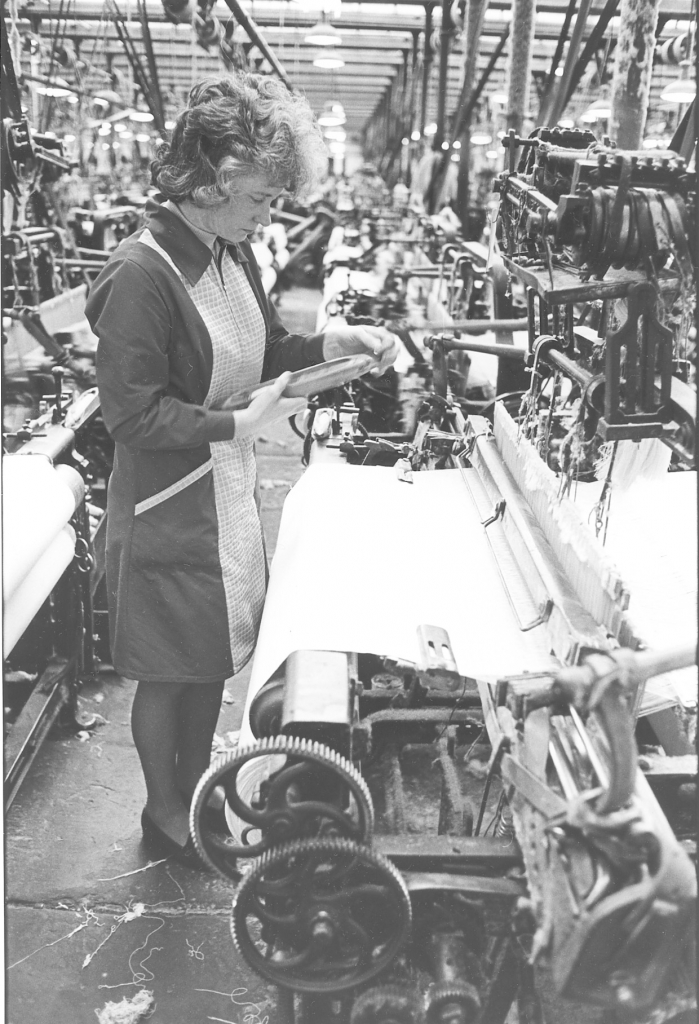
R- Me weft’d broken, weft had broken, which the loom would stop. I’ve taken the pirn, the shuttle out, and it looks like I've found the fault. Yes, I’ve found, I'm threading me shuttle again ready for going back in. It might been just cut you know, sometimes in the winding room, happen a lump of dawn, something fast.
Yes, now on 14 you're pulling some more weft off, and your hands are moving that fast again.
R – Fast..
You're pulling some thread off. Once you've threaded it, would you pull some through the eye to make sure it was running properly?
R - Yes I would, make sure it weren't trying, you know make sure it weren't broken again. Yes.
And then on 15, what ...
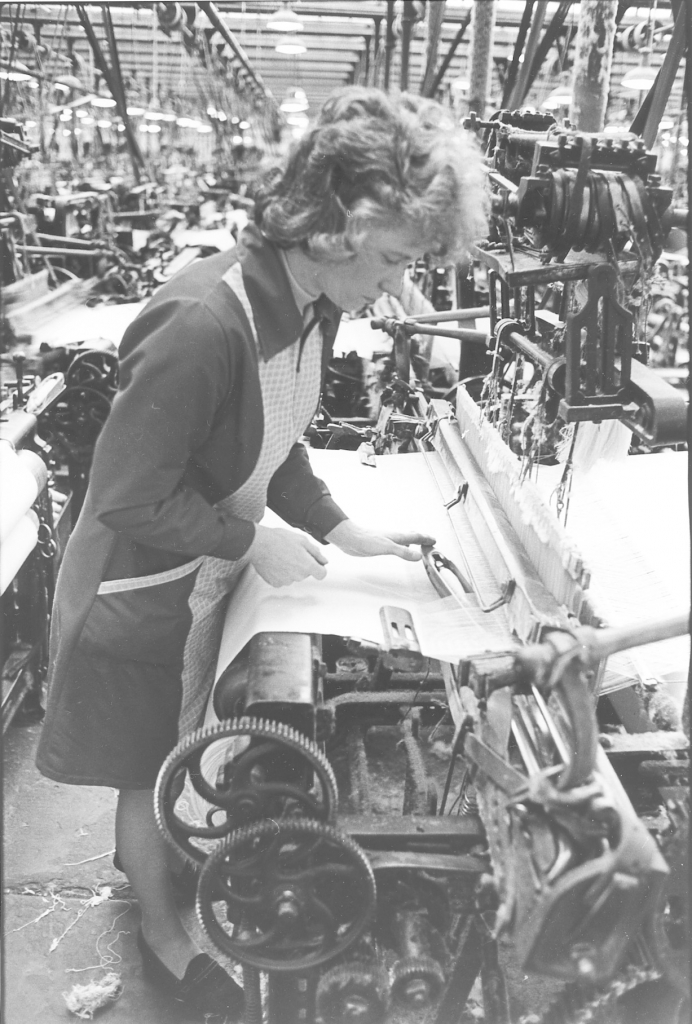
R - I'm putting me shuttle in on the off side. The weft must have broken on the off side so I'm putting me shuttle in at that side and then I would knock, send the shuttle back across to the starting side, and then let the wheels back again.
You’d have to let them back again aye, yes.
R – Yes, I let them back again. And then on picture 17 I’m just setting the loom on again.
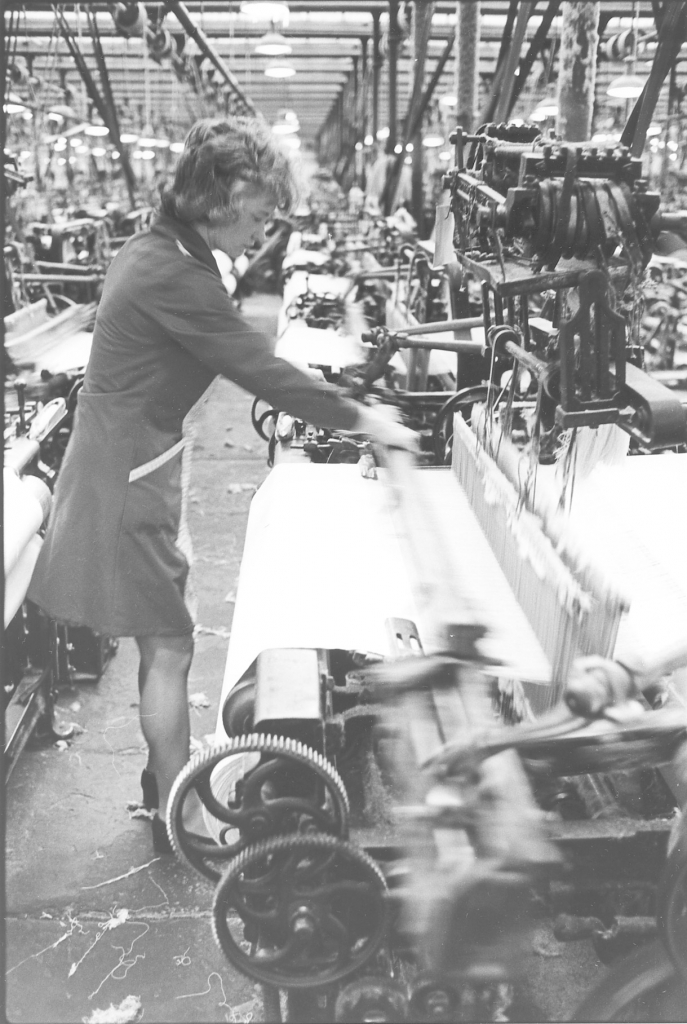
(45 min)
Yes. Now there is something about that picture number 17 which is this. It's the reason really why this in. A lot of weavers wouldn’t have bothered. If you look at that shuttle that you were putting back in there in like less than half a pirn there isn't there or less than that. A lot of weavers wouldn’t have bothered would they? They'd have whipped that out and put…
R - Put a full one on. Yes, no they wouldn't have bothered, they would have thrown it and sent it back as waste which in just wasteful really.
Yes, they wouldn't have bothered. Yes. Well that, you see, that's the reason why that's in, because to me that says a lot about the sort of weaver that you are, it's the difference between a good weaver and a bad weaver. I mean, those pirns, they add up in a day don't they.
R- Oh yes.
And that's the reason in the old days, why they used to have to go and take the waste into the warehouse didn't they?
R- In the warehouse. Yes.
Have you ever had to take your waste in like that? You know, they used to, used to have to take it to somebody [to be inspected]didn’t they.
R - Yes. I used to take it, at Slaters I used to take it and put it in a box. I never had to take it to anybody, I used to go and shove it in a box that’s all.
Have you ever heard of anybody being pulled up for making too much waste?
R- No, I don’t think so. Because it all goes in one box you see, unless they see you throwing it in they don't know who’s it is.
Yes. That's it. Because in the old days it used to be a big thing didn't it, I don't know whether you've heard old weavers talking about it, it used to be a big thing, they used to say there were more lavatories got bunged up in the mill with waste being put down them…
R - Waste being put down it. A lot used to take the waste home and put it on the fire.
(850)
Do you know what Ernie Roberts said? He said that when he started weaving he used to go in thin and come out fat at night.
R- Fat at night. Yes, broken pirns and one thing and another.
Stabbed cops. Aye, Ernie in his weaving days. He is weaving again isn’t he?
R - He is.
He is weaving at Bendem, can't keep away from it. Gives a good idea that picture, well both 16 and 17, of, you can see all the shafting in the roof and a forest of belts and the lights are on and all! I must have been treating you well that day.
R - Must have been. It didn't make any difference.
Aye, why do you say that?
R- That it didn't make any difference, not much.
What makes you say that? Now tell me about the lighting.
R- Well, they weren't right good lights were they? I mean, be honest.
Oh they weren’t, I agree with you but I want you to tell me.
R - Some days they were lovely and bright and others you could, sometimes you could see them going dimmer and dimmer, and you can get closer and closer to the cloth. You weren’t so bad but when George were there, it were murder sometimes, he wouldn't turn them up.
Ah well, the reason for that, there again I think it's on the tapes somewhere, in that when I went there the alternator was wrong and actually where they should have had 440 Volts they only had 330.
R - Oh, no wonder it were dark half the time.
And that's why, .. well you'll laugh, do you know what used to be .. well, the thing that put me on to it in the end, that there was something wrong, was the fact that the adding machine in the office for the wages would only work if it was on the mains it wouldn't work…
R- It wouldn't work on ..
It wouldn't work on ours. So I thought “We'd better move into the twentieth century and get the voltage checked.” and I found out we were running 110 Volt down.
R- I don’t know .. typical.
It’s a wonder they worked at all actually.
R- Typical Bancroft.
Yes, well, before we just go on to that, we’re just getting to the end of this tape so I'll change the tape over and we'll go on to the other pictures, you know, on a new tape. But ... Yes ... Tell me about being on stone floors all day, walking about on stone floors Mary. I mean, was that any hardship?
R- It were hard work, really. I never noticed it before but it were very, it weren’t so bad in winter but it were very uncomfortable in summer. Your feet used to hurt, it used to get hot. They don't seem to do the same down at Johnson’s, must be a better floor.
That's composition isn’t it, that floor?
R - Yes. Very uneven, you go flying it you aren't careful.
Aye that's so isn't it. Well, another thing, were all your looms fastened down properly?
R- Were they heck! No they weren’t, I don't think so. They'd go for a walk, one or two go for a walk.
What do you mean go for a walk? Tell me.
R - Well, they'd move as if they were running away, they'd move. I had one or two did that at odd times, they weren't fastened down right.
I don't think there was a loom in that shed fastened down properly, they'd shifted them about that many times, ... I think, we should we should have had them on a draught board I think. Anyway, we’ll finish this tape here Mary and go on to a fresh tape.
(900)
SCG/29 January 2003
9,319 words
LANCASHIRE TEXTILE PROJECT
TAPE 79/AF/03
THIS TAPE HAS BEEN RECORDED ON THE 1st OF AUGUST 1979 AT MARY WILKIN’S HOME, 10 MOORVIEW IN SALTERFORTH. THE INFORMANT IS MARY WILKIN, WEAVER AND THE INTERVIEWER IS STANLEY GRAHAM.
Now then, we'll go on now, on picture 18 you are at the other side of your loom aren't you?
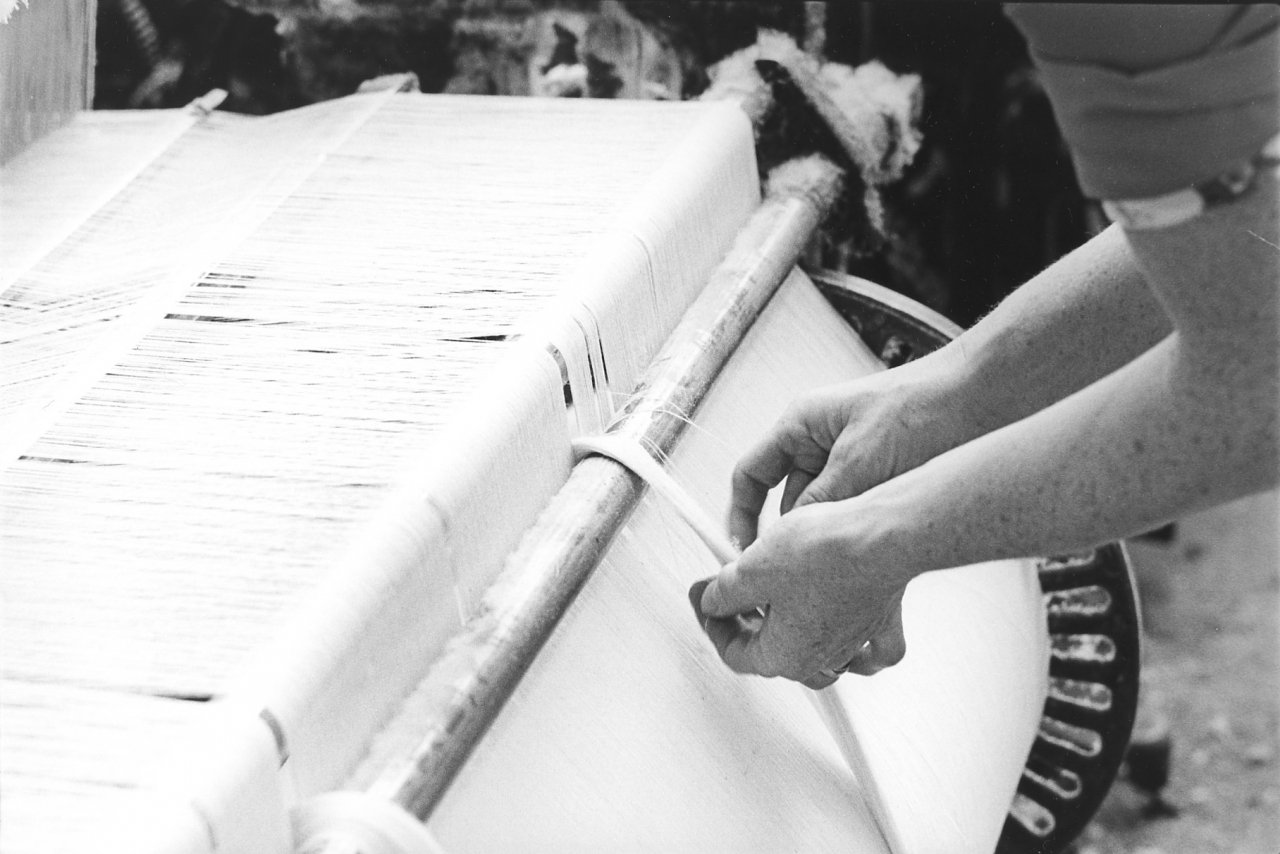
R – Yes. I'm round the back of the loom.
Yes, what are you doing there?
R - Tying spare ends up. Yes, I am tying spare ends up. Some warps, they'd have, they have spare ends, a lot, and some warps wouldn’t have any at all. And some come up, you know, when your, when the bean's running. In that case you left them .. you run ‘em round your beam. You’ve to keep an eye on ‘em or they can get fast. Or else you’ve, sometimes if any end’s drawing off your warp and you can’t find it you put a spare end in until your original end came up and then you put that one back in and tie your spare end back up on your, on the run round.
Aye. So that's what you meant when you said last week that you'd to keep an eye on the back of your loom as well as your front.
R - Oh yes. It's important to keep an eye on the back of your looms. A lot of trouble starts in your, round the back of a loom.
What would you do if you had no spare ends and an end went down?
(50)
R - Well on a lot of them up at Bancroft you could take a side end ‘cause your side ends are always double. Well you could take one of those out providing it weren’t too far in and put that in as your end until your original end come up and then you take that one out and put it back in, back where you got it from, at the side.
Yes, and if you couldn’t put a side end in, what did you do then?
R - You just have to let it run whereas down at Johnson’s you put a pirn, a bobbin down t’back, a bobbin and weft you know?
Yes.
R - And use that as a spare end.
Have I seen people running at Bancroft with an old shuttle on the floor?
R- Yes, that’s what they do, yes. You use that then. When your end comes up you put that one in, take your spare end out, and put your original end back in and carry on.
Aye, that's it. Nineteen Mary. Tell me what you're doing there.
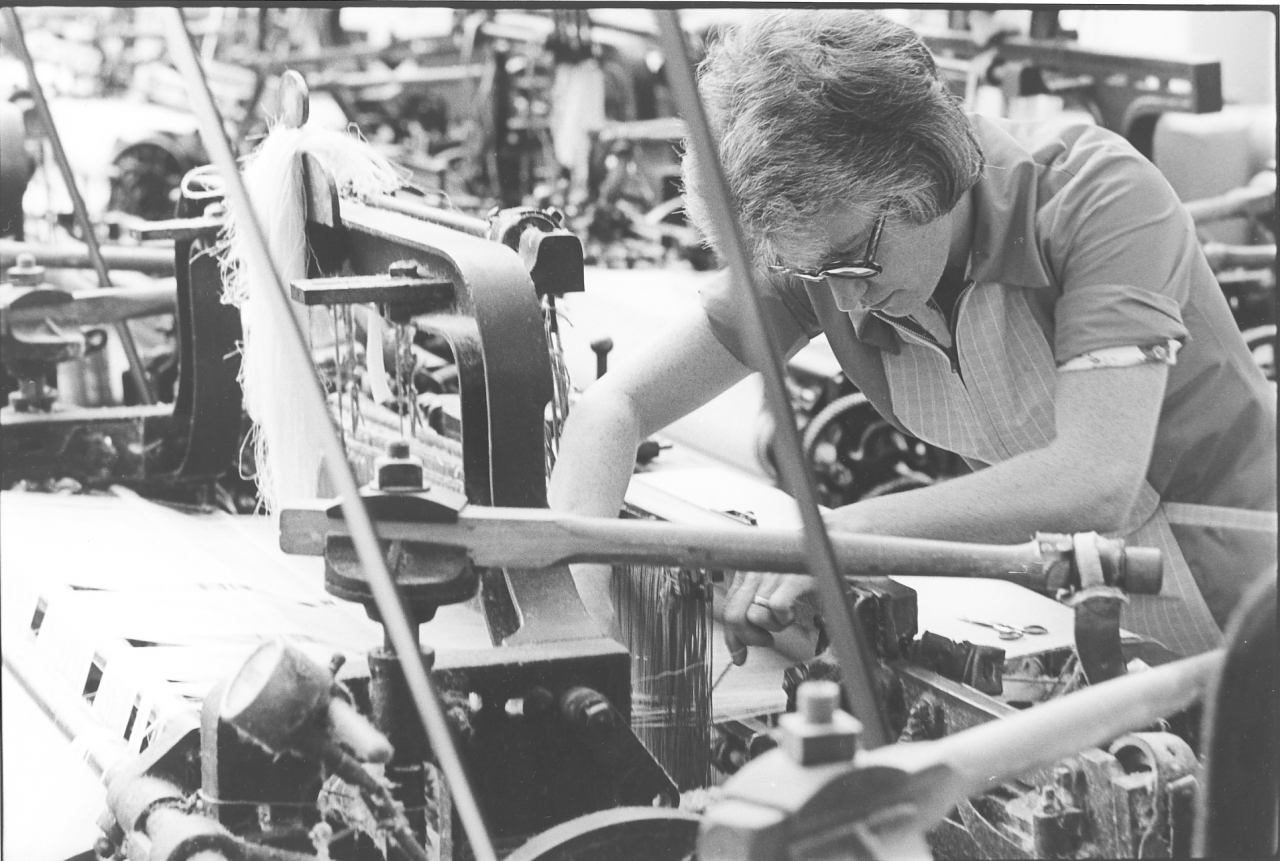
R - Taking some ends up, taking them up through the healds. Yes, that's what I’m doing.
Yes, what’s that you've got in your hand there.
R - That's me reed hook, that’s me reed hook.
And what are you doing with your right hand?
R - Just opening the healds, you know, so that I can see what I am doing. Every weaver needs a reed hook and a pair of scissors, they can’t weave without them, very important. Very important indeed.
Aye. Very important. We'll go on to, go on to 20, because there …
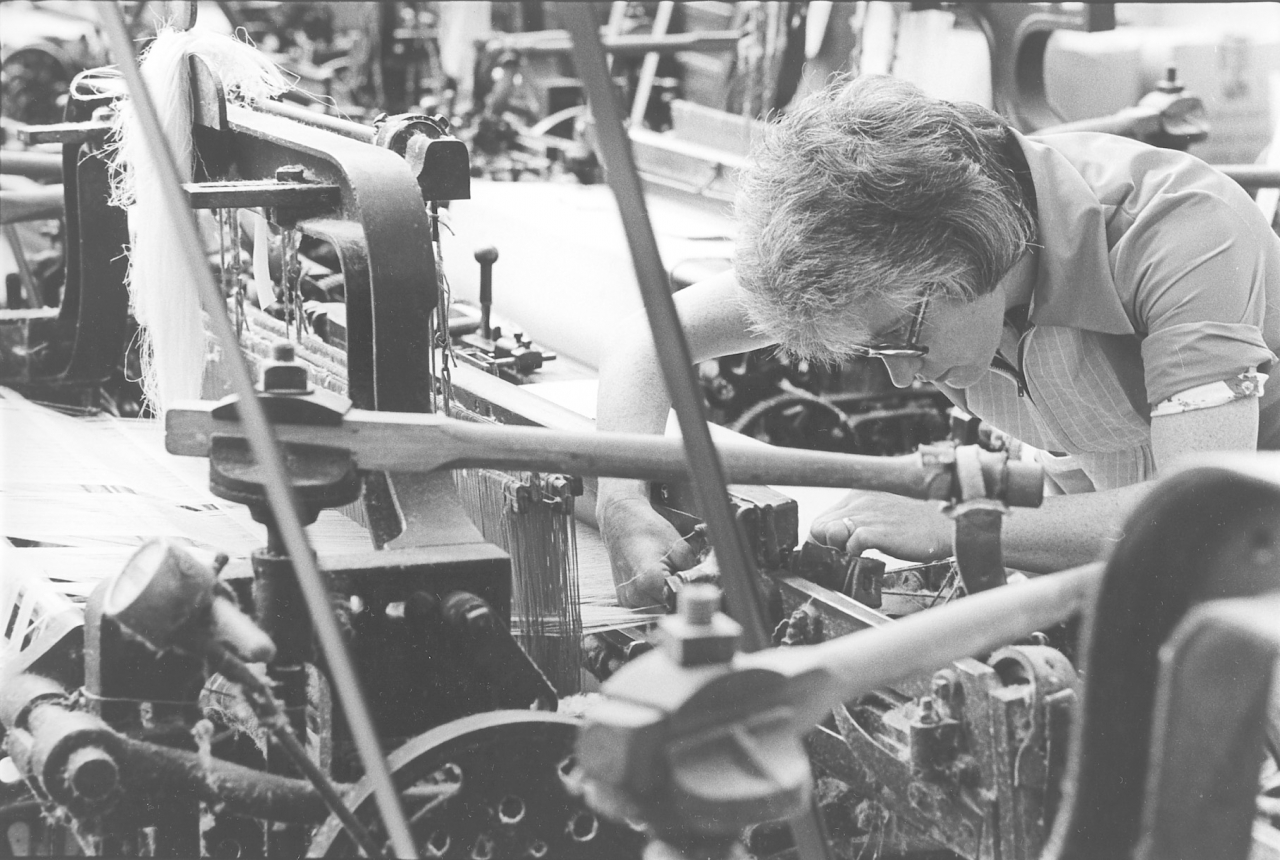
R - Now there I have taken it through the healds, and now I’m putting it in the reed and it looks like I am .. I'm opening the dent with my right
(100)
hand, and taking it up. I've got me reed hook through the dent with me left hand. I’m going to hook it through.
Yes. That’s it. What's on the top of this loom, in front of you? There is a bunch of ends hung over isn't there? What are them for Mary?
R - Yes. That’s beating. Thems the spare ends for piecing your ends when your end comes down. You take one of those and you piece your end and then take it up again.
Yes, so if it isn't long enough to take up properly you just tie a piece of that on to make it longer.
R – Yes. Tie a piece up, yes.
That's it, aye. And on to number 21.
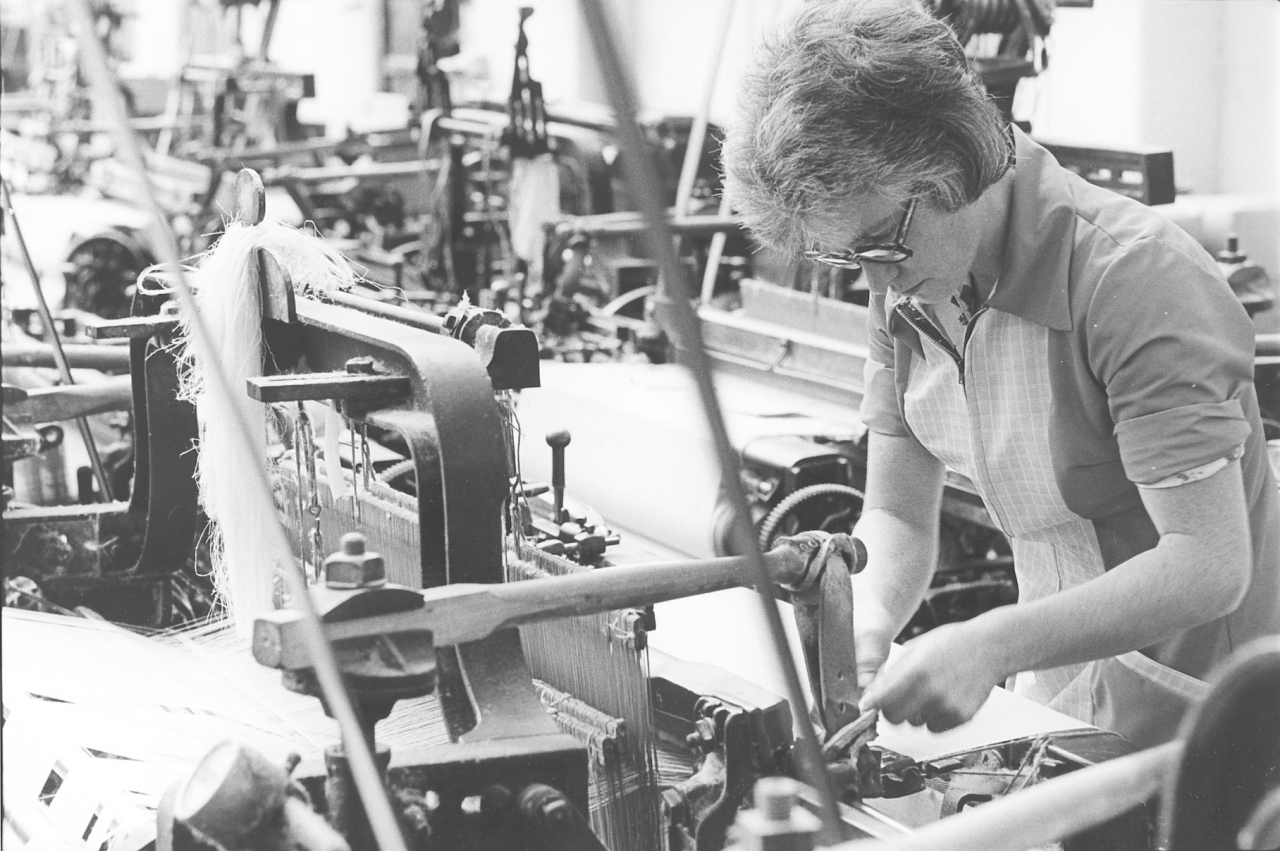
R- Yes, and I have taken it up there. I've pushed the loom back. It looks like I'm fastening the end. I've .. I think I'm fastening this under the temple.
You were doing, you are right. I remember that particularly, you were trapping it under the temple. If it's near the temple, if it's near the side, that’s a good way of keeping it in place, isn't it?
R - It is yes.
Yes, I remember that particularly Mary, when you were doing that, you were, you were trapping it under the temple.
R – Yes. That’s what I’d be doing. Yes, twenty-two, ...
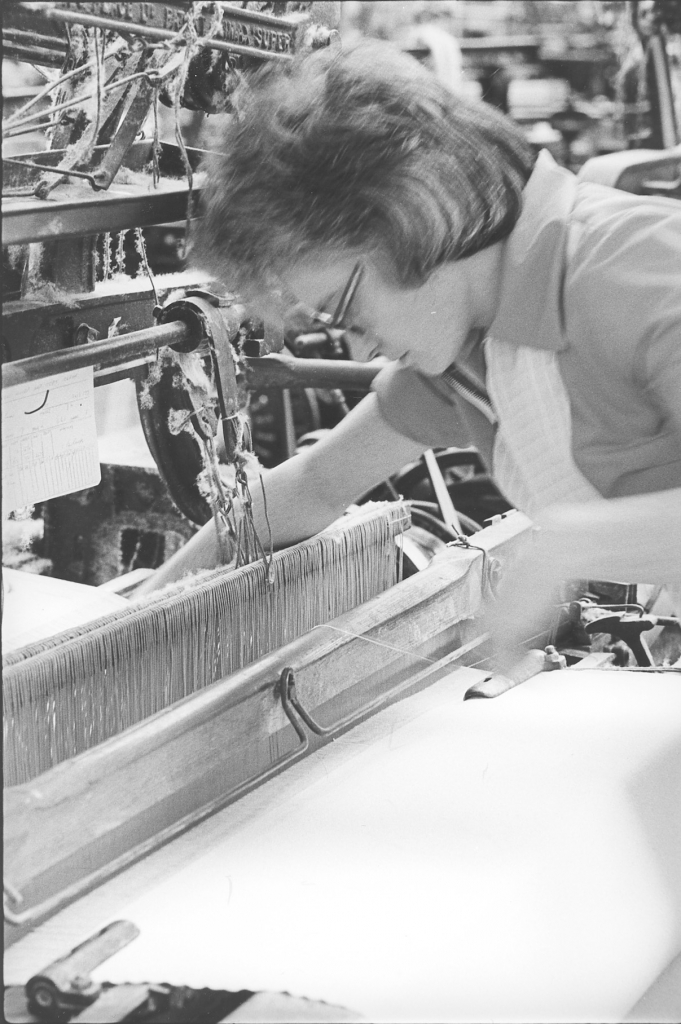
Now that's, that's just the same thing again isn't it?
R - Yes, from a different view. I've taken the end up through the healds ... I am about to take it up, I’ll be taking it up through the reed. Right?
Yes, that's it, aye. Aye, weavers, what the weaver did most of. Now then, 23. Tell me what that is.
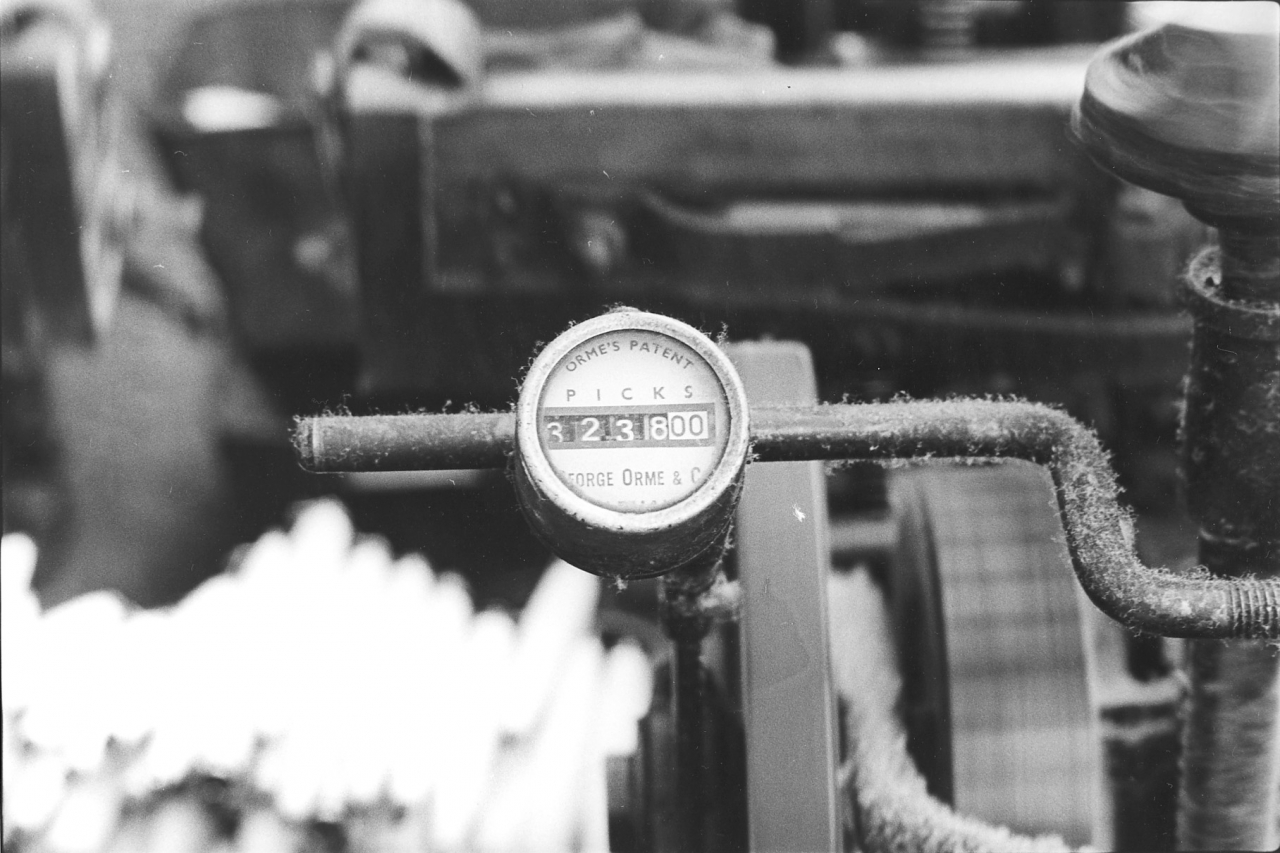
(150)
(5 min)
R- That's your pick clock.
What was that for Mary?
R - I have one of those on every loom and when your loom's running that's running and [counting] how many picks you have on. That's how many, that determines your wage, and how much you've earned off your loom. You get so many picks off each loom.
Yes, now when you talk about a pick, that’s when the shuttle's gone twice through the loom, isn't it? Or is it once?
R – No, once.
Once.
R- But that doesn’t turn over [every pick] I think it turns over every fifty. I think you should put your hand on top of your picking stick and it picks, I think it picks fifty, I think Dorothy told me once it went fifty times and that should change that one. And then at the end of the week they take, at Bancroft they take the first two numbers down and they'd have so many picks on, that’s what you have, what you are doing off that loom. The more picks you got on, the more [wage] you had off ...
So you were paid, you were paid a basic wage and then a pick rate on top?
R - You were paid on your clocks. Yes.
Of course the pick clock was a thing that was put in, and it was going to do the weavers a lot of good, and it never actually did them any good really did it? It didn't make any big difference to their wages.
R- No but you just, you get the same more or less every week, whereas of course if you were… they used to pay you on your piece .. if you didn't get a piece off you wouldn’t get paid for that loom, you know?
[Mary is flagging up the big improvement that pick clocks brought for the weavers. A weaver on piece rates with bad warps in could find they had no wage at the end of the week. This is covered comprehensively elsewhere in the archive. 78/AC/9 has a good description.]
That's it Mary. Now then, last picture, number 24.
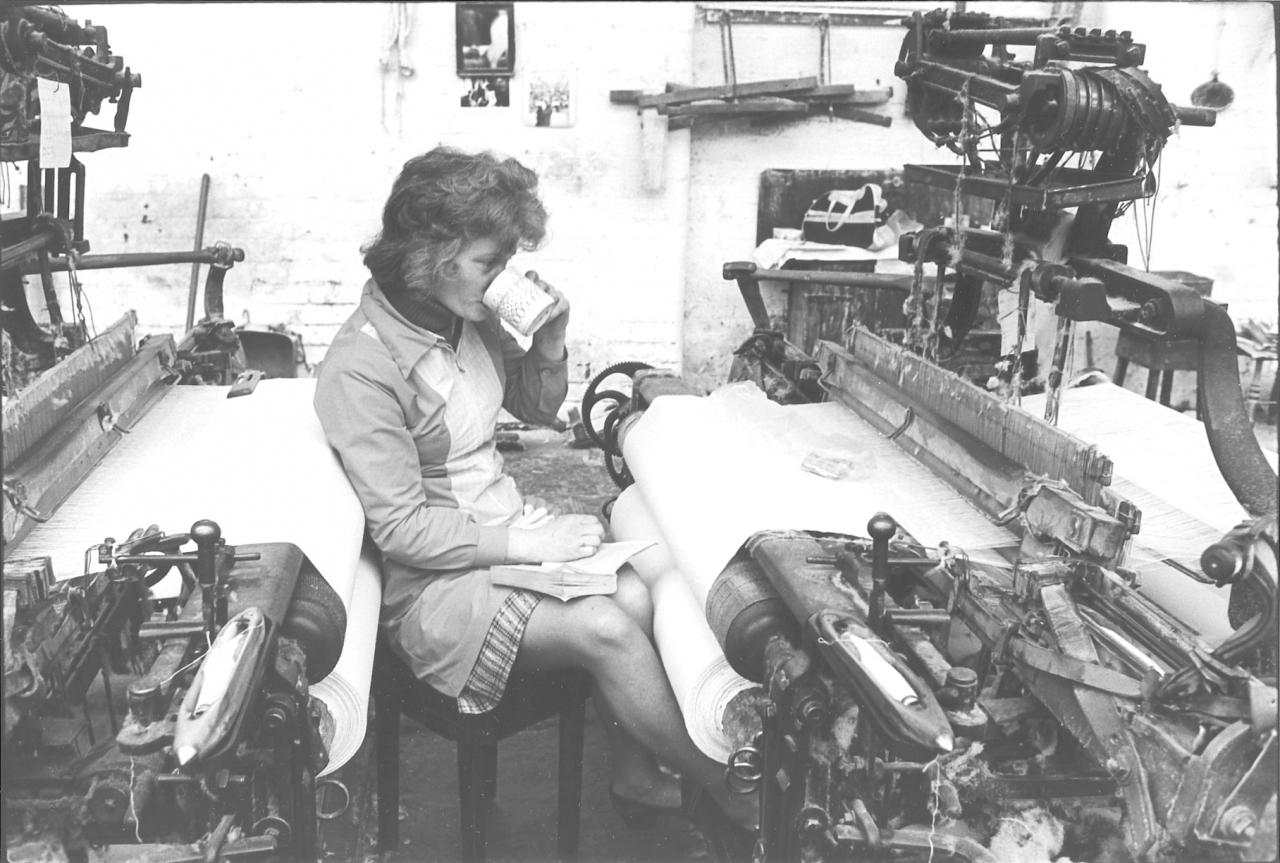
(200)
R - Having me dinner ...
Having your dinner. Now then, nowadays very few people eat their meals at the place of work. Why did you stay by your looms instead of going into the canteen?
R - _Well, they hadn't really got a canteen there, it weren't ... well they had, it was called [the canteen].. but it weren't clean. And you only had half an hour for dinner anyway, so it was easier to stop there, have a cup of tea and a sandwich and a read and go and get ready for work again.
That's it. You always had a clean tablecloth anyway didn't you Mary?
R - Oh aye, always had a clean tablecloth, yes.
Aye. Do you a do you have your dinner at your loom at Johnson’s?
R - Well I work through .. I do, yes I work through me dinner hour though, because . of the buses. [getting away early to catch the bus home]
What do you mean? Oh, with being on electric motors ... ?
R - Well yes because the shed’s running all the time down there because they are shift workers you see. So the shed’s running all the time.
So you don’t stop for your dinner at Johnson's?
R – No.
So you start, what time in the morning?
R - Half seven,
And work right through till…
R - About four o’clock, yes.
By gum Mary, you're a glutton for punishment. Eh .... anyway, thank you very much Mary. That's ..
R – You’re welcome.
That's it, that's described them. Of course all this is gone now, it's all finished. Is it a good job it's gone? You know?
(250)
R - I suppose in a way it is, although we had some good times there. But it were out of date, it weren't ... they were in at a loss I suppose. We thought it was a shame to see a place, to close down, but it's just a sign of the times isn't it, these days?
Aye. Sign of the times. Right, well thanks very much Mary anyway.
[P.S - This was the finish of this tape and in point of fact the finish of the taping with Mary Wilkin and I'd just like to add a postscript. It's not something that I normally do, but the reason why this has been such a brief coverage of Mary is that there were certain difficulties. One of the things about taping people is that it's no use thinking that you can go in and be a disruptive influence in their lives and still get meaningful stuff out of them. And so, obviously, the thing you've got to do is try and not be disruptive. Now as a matter of fact, Mary's husband thought that two sessions of one tape each was quite enough and as a matter of fact when I made the last piece of tape, which is on this tape, he was stood over us. Very sad really, I'd had liked to have spent a lot more time with Mary. I'm also sad about Mary in the respect that she is working far too hard, and she doesn't look well at all. They have no children, they have a large Alsatian dog which anybody that's listened to the tapes will realise ... and they are both working. I don't really know what they’re both working so hard for. It's very sad. Mary doesn’t look well. I think a lot of her and I’m worried about her but there you are, there is nothing I can do about it. And these are only personal opinions anyway. But what I would like people in the future who listen to this tape to realise is that there were certain difficulties and that we did the best we could in the time that was allowed to us.]
This postscript was written in 1979 and not added later.
SCG/29 January 2003
1891 words.
